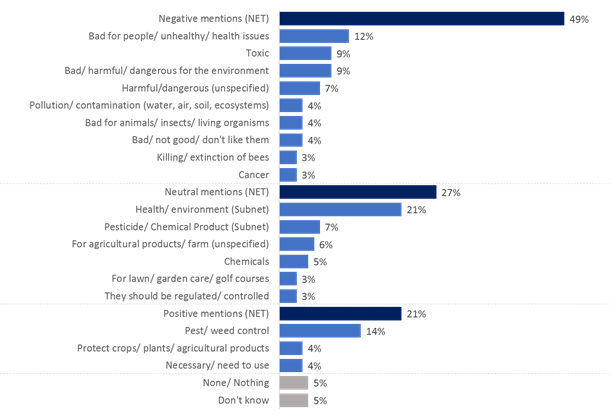
Award Date: 2016-09-16
Contract Number: HT372-163422/001/CY
POR-042-16
Contact Information: por-rop@hc-sc.gc.ca
March 29th, 2017
Ipsos Public Affairs
1 Nicholas Street, Suite 1400
Ottawa ON K1N 7B7
Tel: 613.241.5802
Fax: 613.248.7981
www.ipsos.ca
« Ce rapport est aussi disponible en français »
I hereby certify as Senior Officer of Ipsos that the deliverables fully comply with the Government of Canada political neutrality requirements outlined in the Communications Policy of the Government of Canada and Procedures for Planning and Contracting Public Opinion Research. Specifically, the deliverables do not include information on electoral voting intentions, political party preferences, standings with the electorate or ratings of the performance of a political party or its leaders.
Mike Colledge
President
Ipsos Public Affairs
The Pest Management Regulatory Agency (PMRA), a branch of Health Canada, is pursuing its mandate to prevent unacceptable risks to Canadians and environment from the use of pesticides guided by a new Strategic Plan which outlines a vision in which Canadians are confident that Canada's pesticide regulatory system protects their health and the environment.
The Strategic Plan sets two Strategic Outcomes to be achieved and measured over the next 5 years and to support the opinion and view among the general public that i) PMRA makes evidence-based regulatory decisions and policies that are protective of human health and the environment, in a timely, open and transparent manner, and ii) Canadians recognize that PMRA makes pesticide regulatory decisions that protect their health and the environment. To support these initiatives, a new Communications and Outreach Strategy has been developed.
While PMRA works diligently to make and implement decisions that protect the health and environment of Canadians, efforts to communicate and engage with Canadians have not kept pace. A more deliberate, proactive, open and transparent engagement of Canadians will help to increase understanding of, and confidence in, PMRA's work. In turn, this will support compliance with the requirements of the PCPA, and the broader effectiveness of PMRA's efforts to protect the health of Canadians and the environment.
To support the development of approaches for communications and engagement that are evidence-based and supported by meaningful data - so that resources are directed toward activities that deliver real value to Canadians – quantitative and qualitative research was conducted among a sample of the Canadian general public.
This research was conducted to establish a reliable baseline and understanding of Canadians awareness and confidence in Canada's pesticide regulatory system. Specific research objectives for each phase of research included:
Quantitative research
Qualitative research
This research will be used to establish the baseline awareness and opinions of Canadians about the pesticide regulatory system in Canada and will allow the assessment of key messages and techniques as part of the 5-year Communications and Outreach Strategy. This research also will enable future assessments to be repeated in order to determine changes and trends in the intervening years as well as to gauge the effectiveness of communication, engagement and outreach activities.
This report details the results of this research, conducted in two parts (quantitative and qualitative), between October 2016 and November 2016. The total contract value of this research was $74,981.10 including HST.
The key audience for this study include members of the Canadian general pubic, aged 18 or older.
This research was conducted in two phases:
For the quantitative survey, the i-Say panel provides a number of innovative incentive programs to participants tailored to the specific requirements of each survey, depending on the length of the survey, the subject matter of the study, and the time required to complete a minimum number of interviews. A point-based system is used where participants can redeem points for various items.
For the qualitative focus groups, Ipsos provided an honorarium of $75.00 CDN to participants to attend the focus groups in order to encourage full attendance.
This report contains the findings from both the quantitative online survey and the qualitative focus group sessions.
The data were weighted to the Canadian population data by region, gender, and age. All sample surveys and polls may be subject to other sources of error, including, but not limited to coverage error and measurement error. Where figures do not sum to 100, this is due to the effects of rounding.
Survey respondents and focus group participants generally associate pesticides with negative connotations though the vast majority say they haven't seen read or heard anything about them in the past three months. Survey results show that women and those who report low levels of knowledge about the pesticides regulatory system are more likely to associate them with negative thoughts. Focus group discussions highlighted a similar dynamic among participants. Young people (18 to 34) and those who use pesticide products are more likely to have heard something, as are those who are not confident that the PMRA is doing its job.
While more survey respondents agree that pesticides are necessary and serve a purpose than those who disagree, half say they are unsure. Those more likely to agree include older respondents (55 years of age and older) with higher income levels who use pesticides at least sometimes, those who consider themselves to be knowledgeable about the pesticides regulatory system in Canada, those who are aware that Health Canada regulates pesticides, and those who are confident in the job the PMRA is. Women and younger respondents (18 to 34) are more likely to disagree.
The extent of acceptability of use of pesticides was led by factors such personal control over product use (such as when used by a consumer around the home, compared to industrial or agricultural use) and scale (once again, such as private use in the home, compared to in the commercial forestry sector or public green spaces). Respondents were least comfortable with the use of pesticides on food imported into Canada and on fruits and vegetables, and their products, sold in Canada or exported. Knowledge of the regulatory system, use of pesticides (experience with products) and confidence in the PMRA to protect health and the environment drive higher ratings of acceptability. Older Canadians also tend offer higher acceptability ratings in various areas of use.
Focus groups allowed for a better understanding of survey results with regards to pesticides' usefulness and the role played by the Government of Canada. Discussions thus highlighted that most participants had limited awareness of the positive role of pesticides. They tended to focus on the negative aspects of large-scale commercial and agricultural usage, which they associated with serious health risks for humans and animals. Many believed that there were better, healthier, alternatives to what they viewed as dangerous chemicals. Women and participants in Montreal were more likely to hold this point of view.
Despite their negative outlook on pesticides and lack of awareness in general, most focus group participants felt that the Canadian government must be doing a good job at protecting them from the harmful effects of pesticides. This vague impression was driven by two main elements. One was a simple observation: they rarely heard of issues related to pesticides and therefore, assumed that regulators must be doing something good to protect humans and animals. The second element was a more general belief that the Canadian government probably tried to do what was best for Canadians, although not all participants agreed, especially in Montreal.
Focus groups were also used to test a series of messages that may be used to communicate with Canadians regarding pesticides and pest control products use and regulations in Canada. Overall, the messaging tested in the four groups was well received. Most participants, especially in Toronto, were reassured by what they read and felt that it provided good information. Because they lacked awareness about the regulation system, participants were reassured to know that Health Canada was directly involved in ensuring that pesticides and pest control products used in Canada complied with stringent rules and regulations before they could be used.
Throughout message testing discussions, it was very clear that the mention of scientists or scientific evidence in various messages was reassuring for almost all participants. Participants did not automatically assume that scientists were involved in Health Canada's regulation and investigation efforts and wanted to be told as such because they had a higher degree of trust in scientists than in other spokespersons, whether it be the Health Minister or another person or group.
The analysis presented in this report are derived from both qualitative and quantitative phases of research. Because both phases shared common objectives as well as separate ones, each section of the report does not automatically present a combination of quantitative and qualitative findings. For clarity and simplicity, the report is mostly constructed around quantitative survey results, with qualitative findings included where relevant. The final section of the report on message testing is derived entirely from the qualitative portion of the research.
Respondents generally associate pesticides with negative connotations though the vast majority say they haven't seen read or heard anything about them in the past three months. Women and those who report low levels of knowledge about the pesticides regulatory system are more likely to associate them with negative thoughts. Young people (18 to 34) and those who use them are more likely to have heard something, as are those who are not confident that the PMRA is doing its job.
Top-of-mind thoughts about pesticides and pesticide use conjured up predominantly negative associations (49%) such as 'Bad for people/ unhealthy/ health issues' (12%), 'Toxic' (9%), and 'Bad/ harmful/ dangerous for the environment' (9%). Around one in five (21%) mentioned a more positive association highlighting the benefits of pesticides and pest control products such as 'Pest/ weed control' (14%), 'Protect crops/ plants/ agriculture products' (4%) and 'Necessary/ need to use' (4%).
Figure 1: Top-of-Mind Thoughts Aout Pesticides and Pesticide Use

Q1. What comes to mind when you think about pesticides and pesticide use? [OPEN RESPONSE]
Base: All Respondents (n=2,015)
Only mentions of 3% or greater shown in chart.
'NETS' shown are combined groups of similar answers.
Respondents in British Columbia (51%), Quebec (59%) and Atlantic Canada (58%) were significantly more likely to provide a mention with a negative connotation, compared to those in other regions; as were female respondents (55%, compared to male respondents (43%)); those who indicate they are not very or not at all knowledgeable about the pesticides regulatory process in Canada (51% vs 40% very/somewhat knowledgeable); those who indicate they are aware that Health Canada assesses the safety of pesticides before deciding whether they can be registered for sale and use in Canada (54% vs 49% not aware); and those who are not very or not at all confident that Health Canada's PMRA protects health and the environment as per the Pest Control Products Act (60% vs 48% very/somewhat confident).
While many indicate a negative initial perception of pesticides, few respondents indicate they had actually seen, read, or heard much about pesticides over the last three months (preceding the survey fieldwork period). While 18% of respondents indicate they had heard 'a lot' (4%) or 'something' (14%), around eight in 10 (79%) indicate they had seen/read/heard 'not too much' or 'nothing at all'. These results are indicative of the relatively 'distant' relationship respondents have with pesticides in their day-to-day lives. These results closely match what was heard in focus groups, where most participants struggled to recall precise news items or other information they may have heard or seen with regards to pesticides.
Figure 2: Seen, Read, or Heard About Pesticides Over Last Three Months
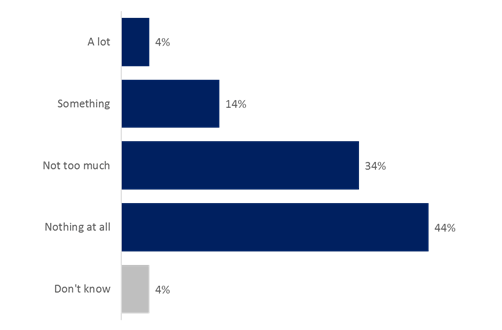
Q5. Over the last three months, how much have you seen, read or heard about pesticides? [SINGLE CODE]
Base: All Respondents (n=2,015).
Those indicating a higher level of recall about pesticides ('A lot' or 'Something') included younger respondents aged 18-34 (21%) or older respondents aged 55+ (18%), compared to those aged 35-54 (14%); those living in more urban areas (20%), compared to suburban areas (14%); those who indicate French as their mother tongue (22%), compared to English (17%); and those who have personally used a pesticide or pest control product 'Often' or 'Sometimes' within the past 12 months (27%), compared to those who 'Rarely' or 'Never' used such a product (14%).
Those who indicate they are 'Not very' or 'Not at all' confident that Health Canada's PMRA protects health and the environment as per the Pest Control Products Act were more likely to indicate that they recalled 'A lot'/'Something' about pesticides over the last three months (24%), compared to those who are confident (17%).
Top-of-mind associations with pesticides during focus group discussions, gathered through a free-association exercise using the word “pesticide”, closely mirrored survey results. Indeed, the vast majority of group participants in both locations instinctively associated pesticides with negative concepts: pollution, toxicity, dangerous, not natural, bad, harmful, dirty fruits and vegetables, poison. While more neutral words like chemicals, insects, tomatoes, or apples were also associated to pesticides, they were often accompanied by a negative explanation: “I said 'apple' because I know they use a lot of chemicals to keep them pretty, but I would rather eat an imperfect apple than a pretty one with all those chemicals”.
These top-of-mind views also reflected a desire by many participants to get rid of pesticides altogether, a view that was more prevalent in Montreal than in Toronto. Only after some probing did more positive aspects of pesticides such higher crop yield, protection against infections and other benefits, started to surface. The benefits of pesticides were thus understood if probed directly, but many, especially in Montreal, doubted that these benefits were worth the risks involved. Women in both locations appeared more likely to refute any benefits that could be attributed to pesticide use.
Another key finding from the unprompted discussion of pesticides was that participants more instinctively thought of industrial or commercial usage, while rarely focusing on household use for pests or insect repellent. The images that more readily sprung to mind were crop dusting, agricultural fields, dangerous chemicals and uses that related to more cosmetic concerns such as green lawns or great looking fruits and vegetables.
Pesticide and pest control products that are commonly used at home, such as insect repellents, ant or mouse traps, were deemed as more benign in general, although participants remained conscious that care should be taken when using them. Some participants spontaneously compared them with other household products that could pose a risk if used improperly, such as cleaning products or over-the-counter medication.
Discussions were also very enlightening in that they clearly showed how the terms pesticides and pest control are viewed as two completely different concepts. In both French (produits anti-parasitaires) and English, the concept of pest control evoked more positive reactions than pesticides. In English, many participants felt that pest control was a necessity and could possibly be done in a humane manner, while pesticides were first and foremost about killing things, something not all participants felt was necessary. Pest control was seen to relate to critters and animals, while pesticides were seen to relate to smaller organisms, like bugs and diseases. In French, the notion of “anti-parasitaire” was directly linked to human medicine. Participants did not think about getting rid of pests, but about internal parasites for human beings. As such, the term sounded much more positive than pesticides.
While more respondents agree that pesticides are necessary and serve a purpose than those who disagree, half say they are unsure. Older respondents (55 years of age and older) with higher income levels who use pesticides at least sometimes, who consider themselves to be knowledgeable about the pesticides regulatory system in Canada and are aware that Health Canada regulates them and are confident in the job they are doing are more likely to agree. Women and younger respondents (18 to 34) are more likely to disagree.
Most agree that pesticide use by homeowners on residential properties and in building materials is acceptable. Views are more mixed when it comes to the forestry sector and agricultural settings and are divided on the issue of whether it is acceptable to use them in public green spaces or the food industry. Knowledge of the regulatory system, use of pesticides and confidence in the PMRA drive higher ratings of acceptability. Older Canadians also tend offer higher acceptability ratings in many areas.
Awareness that there are natural alternatives to conventional pesticides is relatively low with only four in 10 saying they agree that these products are available, but the desire to use them is high with half of respondents indicating they would prefer to use them. Older respondents, women and those with lower incomes are more likely to agree that they are available and that they would prefer to use them. The same is true for those who have heard something about pesticides in the past three months, rarely or never use pesticides and report low levels of confidence in the PMRA.
Views are mixed when it comes to the safety of pesticides. Again, women and younger respondents are more likely to be skeptical. Residents of Quebec are also more likely to be apprehensive. Confidence in Health Canada's PMRA to protect health and the environment as per the Pest Control Products Act appears to contribute to alleviating these concerns. That said, when asked about a range of specific pesticide products, agreement that they can all be used safely is high. Men, older respondents and those with higher household incomes are more likely to agree that all products listed can be used safely.
Only three in 10 respondents use pesticides often or sometimes and they tend to be older men living in rural areas. They also tend to consider themselves to be knowledgeable about the pesticides regulatory system in Canada, aware that Health Canada regulates the sector and confident that the PMRA is doing its job.
While six in 10 respondents agree to some extent that they always read the label when they use pesticides, only a third say they can use pesticides safely if required. Again, older men living in rural areas are most likely to agree that they can use a pesticide product safely. Women are more likely to agree that they always read the label. Again, knowledge, use and confidence in the PMRA drive agreement that respondents can use pesticides safely and that they always read the label.
Despite any prevailing safety concerns, around three in 10 (29%) completely agree (rating of six or seven on a 7-point scale) that pesticides are necessary and serve a purpose. This expands to just over half (51%) when considering the top-three box rating (5,6,7).
Figure 3: Agreement That Pesticides Are Necessary and Serve a Purpose

Q6. Using a scale from 1 to 7 where ''1'' is not at all and ''7'' is completely, to what extent do you agree with each of the following statements? Pesticides are necessary and serve a purpose. [SINGLE CODE PER ATTRIBUTE]. Base: All Respondents (n=2,015)
Those more likely to agree (rating of 5,6,7) that pesticides are necessary and serve a purpose include older respondents aged 55+ (59%), compared to younger respondents aged 35-54 (51%) or aged 18-34 (41%), those living in higher income households ($100k+, 57%), compared to those in lower income households ($40k-<$60k, 49% / <$40k, 44%), those who have used pesticide or pest control products often or sometimes within the past 12 months (75%, vs 42% who have), those who indicate they are very or somewhat knowledgeable about the pesticides regulatory process in Canada (61% vs 49% who are not knowledgeable), those who are aware that Health Canada assesses the safety of pesticides before deciding whether they can be registered in Canada (57% vs 49% who are not aware) and those who are confident that Health Canada's PMRA protects health and the environment as per the Pest Control Products Act (63% vs 34% who are not confident). Women (27% vs 18% of men), those aged 18-34 (24%) and those aged 55+ (25%) vs those aged 35-54 (19%) are more likely to disagree (rating of 1,2,3) with this statement.
Those more likely to 'sit on the fence' (providing a rating of 4) include those in Quebec (23%) or Ontario (21%) vs those in Saskatchewan (10%), younger respondents aged 18-34 (25%) or aged 35-54 (23%) vs older respondents aged 55+ (14%), those who rarely or never use pesticide products (23%) vs those who often/sometimes use them (15%), those who have seen, read or heard 'not too much'/'nothing at all' (22%) vs those who have seen, read or heard 'a lot'/'something' (15%), and those who are not aware that Health Canada assesses the safety of pesticides (22%) vs those who are aware of this (17%).
When asked to rate the extent to which a variety of possible uses of pesticides are acceptable, nearly two thirds (64%) say it is either very (19%) or somewhat acceptable (45%) to use them in 'residential private property, by homeowners.' Nearly as many (61%) say that it is either very (16%) or somewhat (45%) acceptable to use them 'on building materials such as plywood and hardwood flooring.' Just over half (54%) say that use 'in the commercial forestry sector' it is either very (13%) or somewhat (41%) acceptable.
However, respondents are divided on whether it is acceptable to use pesticides 'in and around barns where agricultural animals are housed, such as poultry houses and cattle barns.' Half of respondents (47%) say that it is either very (11%) or somewhat (36%) acceptable while nearly as many (43%) disagree either strongly (17%) or somewhat (26%).
When it comes to using pesticides in 'public green spaces' more respondents (51%) say that it is either not at all (20%) or not very (31%) acceptable while only two in 10 (41%) say it is either very (9%) or somewhat (32%) acceptable. Similarly, half of respondents (53%) say it is either not at all (24%) or not very (29%) acceptable to use pesticides in 'food to be imported in to Canada' while only two in 10 (38%) say it is either very (9%) or somewhat acceptable (29%). Finally, respondents are also more likely (52%) to say that it is either not at all (23%) or not very (29%) acceptable to use pesticides in 'fruits and vegetables, and their products to be sold in Canada or exported.'
Figure 4: Acceptability of Pesticides / Pest Control Product Use
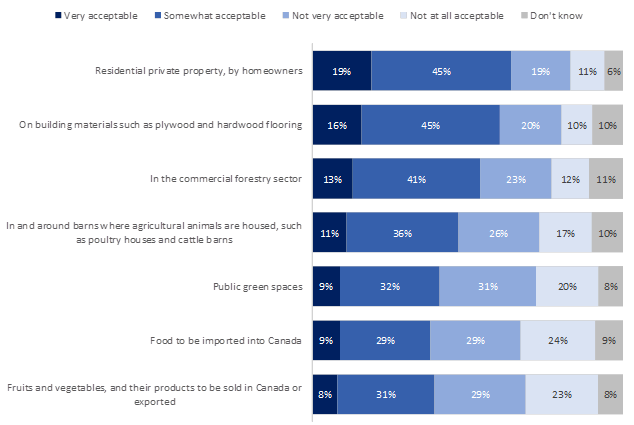
Q4. To what extent do you think it is acceptable to use pesticides/pest control products in each of the following areas? [SINGLE CODE PER ATTRIBUTE]. Base: All Respondents (n=2,015)
Those more likely to say that it is either very or somewhat acceptable to use pesticides in all locations or sectors tested include men and those who:
Respondents living in a household with an income of $100K or more per year are more likely than any other income group to say that it is either very or somewhat acceptable to use pesticides on 'fruits and vegetables, and their products to be sold in Canada or exported' (45%) and 'food to be imported into Canada' (45%). They are also more likely (60%) than those living in lower income households of less than $40K a year (50%) or between $40K and $60K (51%) to say that it is either very or somewhat acceptable to use pesticides 'in the commercial forestry sector' or in 'public green spaces' ($100k+ (47%) vs <$40k (37%) and $40k - <$60k (39%)). These high-income earners (64%) are also more likely to say it is either very or somewhat acceptable to use them 'on building materials such as plywood or hardwood flooring' when compared to those earning less than $40K (57%).
Older respondents (55 years of age and older) are more likely (60%) than 18 to 34 year olds (46%) and 35 to 54 year olds (53%) to say that is somewhat or very acceptable to use pesticides 'in the commercial forestry sector.'
Further, those who say they have seen, read or heard 'not too much' or 'nothing at all' about pesticides in the last three months are more likely to say that it is acceptable to use pesticides in 'residential private property, by homeowners' (65%) compared to 59% among those who have seen, read or heard 'a lot' or 'something' and 'on building materials such as plywood or hardwood flooring' (62%, vs 56% 'a lot'/'something'). Conversely, those who have seen, read or heard 'a lot'/'something' in the past three months are more likely to think it is acceptable to use pesticides 'in and around barns where agricultural animals are housed, such as poultry houses and cattle barns' (54%), compared to those who have seen, read or heard 'not too much' or 'nothing at all' about pesticides (47%).
Residents of Manitoba (64%) are most likely to say that use in 'public green spaces' is acceptable, compared to those in BC (42%), Saskatchewan (46%), Ontario (44%), Quebec (30%), and Atlantic Canada (30%).
Respondents were asked, on a scale of agreement, where seven means 'completely agree' and one means 'not at all', whether they agreed that 'there are natural alternatives to pesticides that are as effective as conventional pesticides.' Despite the finding that most (58%) agree at least somewhat with this statement (offering a rating of 5,6,7), just two in 10 (22%) completely agreed that natural alternatives are available (offering a rating of 7). Fifteen percent disagreed (with a rating of 1,2,3) and twelve percent answered they 'don't know.'
Despite relatively low awareness that effective natural alternatives exist, two thirds of respondents (65%) agree that they 'would prefer to use a homemade/natural/organic pest control option than a registered pesticide'. Half of respondents (51%) offer a rating of either six or seven indicating strong agreement with this statement. A third (33%) offer a rating of three, four or five. Just seven percent give a rating of two or one, indicating disagreement with this statement.
Figure 5: Agree/Disagree
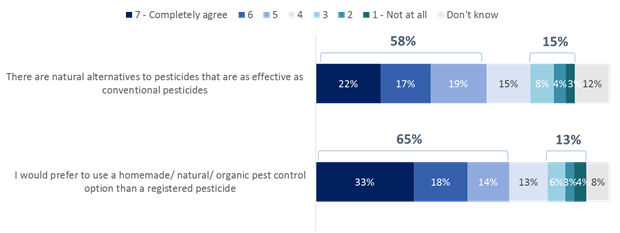
Q6. Using a scale from 1 to 7 where ''1'' is not at all and ''7'' is completely, to what extent do you agree with each of the following statements? There are natural alternatives to pesticides that are as effective as conventional pesticides. / I would prefer to use a homemade/ natural/ organic pest control option than a registered pesticide. [SINGLE CODE PER ATTRIBUTE]. Base: All Respondents (n=2,015)
Those most likely to completely agree (6 or 7 on a 7-point scale) that 'there are natural alternatives to pesticides that are as effective as conventional pesticides' include:
And, those who:
Those more likely to provide a rating of 4 (neither agreeing, nor disagreeing) to this statement include residents of Ontario (17% vs those in Quebec, 12%), men (17% vs women, 13%), those aged 18-34 (18% vs aged 55+, 12%), those living in households with an annual income of <$40k (18% vs $40k-<$60k, 12%), those who often/sometimes use pesticide products (18% vs rarely/never, 14%) and those who answer 'don't know' when asked the extent to which they are confident that Health Canada's PMRA protects health/environment as per the Pest Control Products Act (19% vs those who are not very confident (13%)/not at all confident (10%).
Those most likely to completely agree (6 or 7 on a 7-point scale) that they 'would prefer to use a homemade/ natural/ organic pest control option than a registered pesticide' include:
And, those who:
Those more likely to provide a rating of 4 (neither agreeing, nor disagreeing) include men (16% vs women, 11%), those living in households earning between $60k and less than $100k (16% vs $40k-<$60k, 10%), those who first learned a language other than English or French as a child (18% vs those whose mother tongue is French, 12%), those who often/sometimes use pesticide products (17% vs rarely/never, 13%), those who have seen, read or heard 'not too much' or 'nothing at all' about pesticides (15% vs those who have heard 'a lot' or 'something', 8%), those who are very/somewhat confident that Health Canada's PMRA protects health/environment as per the Pest Control Products Act (14% vs 10% who are not very/not at all confident), and those who indicate they have never looked for information on pesticides (15% vs those who have, 12%).
In general, the low level of awareness about pesticides and pest control products and not feeling adequately informed about these products results in concerns about the safety of their use. Over half of respondents agree they are 'concerned that pesticides and pest control products, even when used as directed, are not safe' (57% providing a rating of 5,6,7). This is particularly so for respondents in Quebec (66%), compared to respondents in all other regions.
Women (62% vs men, 52%), younger respondents aged 18-34 (61%) or 35-54 (58%), compared to those aged 55+ (53%), and those living in rural areas (61% vs suburban areas, 54%) are more likely to agree they are concerned (rating of 5,6,7), as are those from lower income households (<$60k, 63% vs $60k-<$100k, 56% or $100k+, 52%).
Those who were not very or not at all confident that Health Canada's PMRA protects health and the environment as per the Pest Control Products Act were significantly more likely to agree that they are concerned that pesticides and pest control products, even when used as directed, are not safe (74%), compared to 54% who agree with this statement among those who are very or somewhat confident in the PMRA.
Those more likely to provide a rating of 4 (neither agreeing, nor disagreeing) include residents of Alberta (21% vs those in Saskatchewan, 8% or Quebec, 14%), those who have seen, read or heard 'not too much' or 'nothing at all' about pesticides (17% vs those who have heard 'a lot' or 'something', 11%), those who are not aware that Health Canada's PMRA assesses pesticide safety (18% vs aware, 12%), those who are very/somewhat confident that Health Canada's PMRA protects health/environment as per the Pest Control Products Act (17% vs 11% who are not very/not at all confident), and those who indicate they have never looked for information on pesticides (18% vs those who have, 14%).
Fewer agree that they 'think pesticides currently used in agriculture in Canada are safe when used as directed' (45% providing a rating of 5,6,7). Respondents in Quebec (31%) and Atlantic Canada (32%) are significantly more likely to disagree with this statement (indicating a rating of 1,2,3), as were those living in rural areas (27% vs those in suburban areas, 22%).
Those who are very or somewhat confident that Health Canada's PMRA protects health and the environment as per the Pest Control Products Act were significantly more likely to agree (providing a rating of 5,6,7) that pesticides currently used in agriculture in Canada are safe when used as directed (57%), compared to 28% who are not very confident or not at all confident in the PMRA.
Those more likely to provide a rating of 4 (neither agreeing, nor disagreeing) include residents of BC (20%), Alberta (19%), Ontario (20%) and Quebec (22%), compared to those in Saskatchewan (7%), those aged 18-34 (23%) or aged 35-54 (21%), compared to those aged 55+ (15%), those in urban areas (21% vs rural, 16%), and those living in a household earning an annual income of less than $40k (24% vs $40k-<$60k, 17% and $60k-<$100k, 17%).
Figure 6: Agree/Disagree
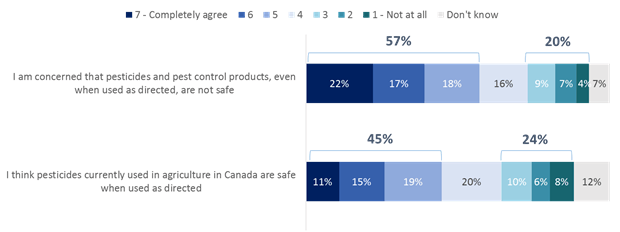
Q6. Using a scale from 1 to 7 where ''1'' is not at all and ''7'' is completely, to what extent do you agree with each of the following statements? I am concerned that pesticides and pest control products, even when used as directed, are not safe. / I think pesticides currently used in agriculture in Canada are safe when used as directed. [SINGLE CODE PER ATTRIBUTE]. Base: All Respondents (n=2,015)
Despite more than half of respondents (57%) agreeing that they are concerned that pesticides and pest control products, even when used as directed, are not safe, when asked to indicate their level of agreement whether specific pesticide and pest control products can be used safely, many do agree they can be. Three quarter of respondents (78%) agree that insect and rodent controlling devices, such as mosquito zappers and mouse traps can be used safely, while around six in 10 agree that animal and insect repellents (64%), Algicides used to control algae in pools and spas (63%), and material and wood preservatives (60%) can be used safely. Respondents were least likely to agree that Herbicides, which are used against weeds, can be used safely (53%).
Figure 7: Agreement That Pesticides and Pest Control Products Can Be Used Safely
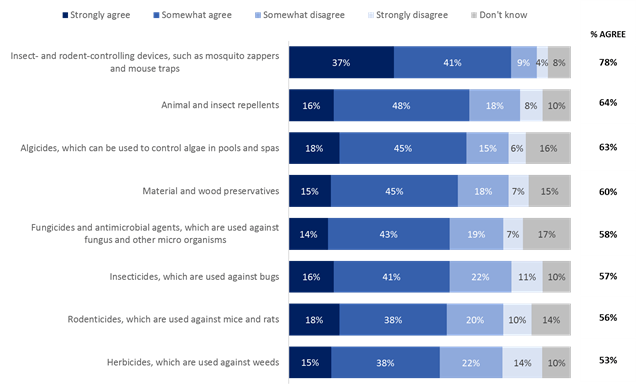
Q2. To what extent do you agree that the following pesticides and pest control products can be used safely? [SINGLE CODE PER ATTRIBUTE]. Base: All Respondents (n=2,015)
Overall agreement (strongly/somewhat) that all products presented can be used safely is highest among:
And, those who:
Just over a quarter of respondents (27%) report using a pesticide or pest control product often (5%) or sometimes (22%) within the past 12 months. Four in 10 respondents (40%) indicate they have not used such a product.
Figure 8: Frequency of Use of Pesticides or Pest Control Products in Past 12 Months
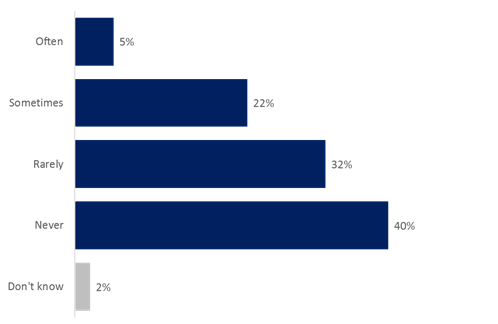
Q3. How frequently within the past 12 months have you used a pesticide or pest control product (such as herbicides, insecticides, fungicides, insect repellants and rodent traps)? [SINGLE CODE PER ATTRIBUTE]. Base: All Respondents (n=2,015)
Older respondents aged 55+ were more likely to indicate frequent use of pesticide or pest control products with seven percent 'often' using such products, compared to three percent of those aged 18-34 who have used these products 'often' in the past 12 months. Those in rural areas were more likely to indicate they often (8%) or sometimes (26%) used such products, as were those who indicate they are very or somewhat knowledgeable about the pesticides regulatory process in Canada (often/sometimes, 52%), those who are aware that Health Canada assesses the safety of pesticides before deciding whether they can be registered in Canada (often/sometimes, 35%), and those who are confident that Health Canada's PMRA protects health and the environment as per the Pest Control Products Act (often/sometimes, 32%), compared to their counter parts who were not as knowledgeable (23%) or aware of the pesticide regulatory process in Canada (22%) or those who were not confident in the PMRA to protect health and the environment (24%).
Around half (52%) of respondents agree (providing a rating of 5,6,7) with the statement 'I can use pesticides safely if required' Just a third (34%) rate their agreement with this statement as a six or seven on a seven-point scale where seven means 'completely agree' and one means 'not at all.' Four in 10 (43%) offer a rating of three, four or five and another 12% rate their agreement as a one or two.
Those more likely to provide a rating of 4 (neither agreeing, nor disagreeing) include residents of Quebec (21% vs those in Ontario (16%), those aged 18-34 (23% vs those aged 35-54, 18% or aged 55+, 11%), those living in a household earning an annual income of less than $40k (21%) or $60k-<$100k (19%) vs those living in a household with an annual income of $40k-<$60k (13%) and those living in $60k-<$100k, 17%), those who rarely or never use pesticide products (19% vs 14% who use them sometimes or often).
While there is some uncertainty over whether or not they can use pesticides safely if required, seven in 10 (74%) agree (providing a rating of 5,6,7) that when they use a pesticide product they 'always read the label.' Just eight percent offer a rating of either one, two or three. However, one in 10 respondents (10%) don't know to what extent they agree or disagree with this statement.
Those more likely to provide a rating of 4 (neither agreeing, nor disagreeing) include residents of Quebec (11% vs those in BC (7%), Saskatchewan (2%) and Atlantic Canada (5%), those aged 18-34 (13% vs those aged 35-54, 8% and aged 55+, 5%), those whose mother tongue is French (10% vs English, 7%) and those who have never looked for information on pesticides (11% vs those who have, 6%).
Figure 9: Agree/Disagree
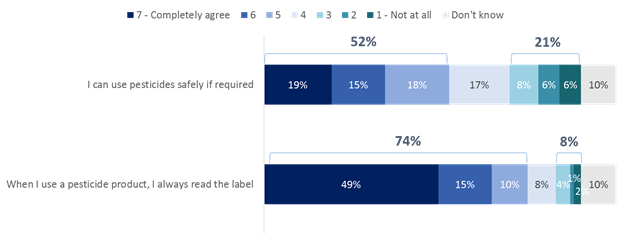
Q6. Using a scale from 1 to 7 where ''1'' is not at all and ''7'' is completely, to what extent do you agree with each of the following statements? I can use pesticides safely if required. / When I use a pesticide product, I always read the label. [SINGLE CODE PER ATTRIBUTE]. Base: All Respondents (n=2,015)
Those more likely to completely agree (6 or 7) with the statement 'I can use pesticides safely if required' include:
And those who say they:
Those more likely to completely agree (6 or 7) that with the statement 'when I use a pesticide product, I always read the label' include:
And those who say they:
As a general rule, participants were fairly confident that pesticide and pest control products sold in Canada were probably safe to use if instructions were followed carefully. Participants appeared more concerned over the effects of commercial pesticide use than by individual or private usage. This higher level of concern over commercial usage stemmed mostly from a direct association between pesticides and food products. Those who expressed concerns thus felt that it was not possible for them to know whether pesticides used on crops were dangerous to them or their families. Most participants did not know where to get credible information regarding the impact of pesticides on their health and that of their family. Food coming from other countries appeared particularly worrisome for participants, with most believing that standards used elsewhere may not be as good as those used in Canada.
Commercial usage also generated more concerns because participants instinctively feared that practices such as crop-dusting or lawn/field spraying could affect people or animals living near the area or using the space for recreational purposes (e.g. parks). While personal usage may pose some risks, they were seen as more limited and, for some, as the responsibility of the person using them. These findings closely match the rankings found in the quantitative portion of the research.
Also in line with survey results, focus group participants with a higher degree of awareness regarding the use of pesticides tended to hold more positive views regarding their private or commercial use because they were more likely to see the benefits, while at the same time expressing concerns over how they were used and in what quantities. Moreover, female participants tended to hold more negative views on pesticides more generally and were more likely to advocate for a complete ban on pesticide use in favour of natural alternatives, without necessarily being able to identify such alternatives.
While only two in 10 agree that they are adequately informed about pesticides and pest control products, nearly half say the information is available if they need it. Older men living in rural areas are more likely to say they are informed. Recent exposure to information about pesticides, knowledge, use and confidence in the PMRA drive agreement that they are adequately informed and that they can get the information they need.
Health Canada's website and home improvement and garden centres are the two most likely sources consulted by respondents when looking for information about pesticides. Those least likely to consult the Health Canada website include those who have looked for information on pesticides in the past who use pesticide products often or sometimes and who are neither aware that Health Canada regulates pesticides nor do they have confidence that the PMRA is doing its job.
The internet and garden centres are the top two sources they have consulted. On the internet, the number stop for information is Google, followed by a pesticide product website with Health Canada in third place. The top subject of their searches is safe-use information followed by health-related information.
In terms of who is they believe the most on this issue of pesticides, respondents offered the highest ratings to the Royal College of Physicians and Surgeons, the Canadian Cancer Society and a Health Canada Scientist; a health Canada spokesperson come in sixth on the list. This suggests that Health Canada should consider communicating its messaging on pesticide use and control via Health Canada Scientists rather than spokespeople and that partnering with the RCPS and the Canadian Cancer Society would lend credibility to campaigns.
Despite the low incidence of having seen, read, or heard about pesticides in general ('a lot' or 'something', 17%), nearly four in 10 respondents agree with the statement 'I am adequately informed about pesticides and pest control products,' (37% offering a rating of five, six or seven on a seven-point scale where seven means 'completely agree' and one means 'not at all'). Around a third (34%) disagree with this statement (providing a rating of 1,2,3) indicating that some do not feel adequately informed about pesticides and pest control products. Seven in 10 respondents provided a response of 'don't know'.
Those more likely to provide a rating of 4 (neither agreeing, nor disagreeing) include residents of Alberta (25%) and Ontario (25%) vs those in Saskatchewan (10%) and Quebec (19%) and those who indicate they are not very or not at all knowledgeable about the pesticides regulatory process in Canada (23% vs those who are, 14%).
While agreement that they are adequately informed about pesticides is not strong, respondents do tend to say that the information they need is available to them. Six in 10 respondents (64%) rate their agreement with the statement 'when I need information about pesticides, 'I am able to get it' as a five, six or seven on the scale. Around one in ten (8%) offer a rating of one, two or three and a further one in 10 (11%) answered 'don't know'.
Those more likely to provide a rating of 4 (neither agreeing, nor disagreeing) those aged 18-34 (20%) and aged 35-54 (16%), compared to those aged 55+ (10%), and those with a high school education (18% vs those with Post-Secondary education, 14%). Those in Saskatchewan were least likely to select a rating of 4 on the agreement scale (5% vs those in all other regions).
Figure 10: Agree/Disagree
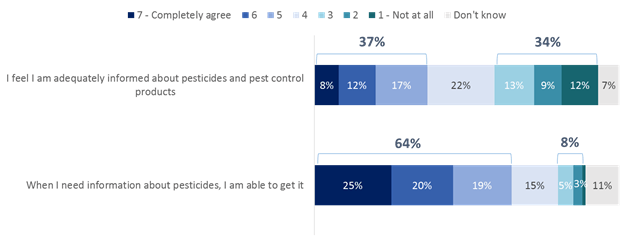
Q6. Using a scale from 1 to 7 where ''1'' is not at all and ''7'' is completely, to what extent do you agree with each of the following statements? I feel I am adequately informed about pesticides and pest control products. / When I need information about pesticides, I am able to get it. [SINGLE CODE PER ATTRIBUTE]. Base: All Respondents (n=2,015)
Those more likely to completely agree (six or seven) with the statement 'I feel I am adequately informed about pesticides and pest control products' include:
And, those who say they:
Those more likely to completely agree (six or seven) with the statement 'when I need information about pesticides, I am able to get it' include:
And, those who say they:
Respondents were asked to rate how likely they would be to look for information on pesticides from a list of possible sources. Among the potential sources tested, respondents are most likely to look to a 'Health Canada' website for this kind of information. Two thirds of respondents (65%) say they are either very (23%) or somewhat (42%) likely to consult this source, while three in 10 (29%) say they are either not very (18%) or not at all (10%) likely to do so. 'A home improvement store/garden centre' receives similar ratings with sixty-four percent saying they are 'very' (17%) or 'somewhat' (47%) likely to consult this source. Nearly as many (59%) are either very (18%) or somewhat (41%) likely to consult 'Government of Canada websites.'
Respondents are divided when it comes to consulting 'a pesticide service provider' or 'environmental groups' for information about pesticides. Nearly half (45%) say they are very (10%) or somewhat (35%) likely to consult a 'pesticide service provider' and the same proportion (44%) are either not very (27%) or not at all (17%) likely to do so. Four in 10 (43%) say they would be very (14%) or somewhat (29%) likely to consult 'environmental groups' and half (47%) say they are not very (25%) or not at all (22%) likely to turn to them for this kind of information. 'Blogs' are the source that are least likely to be consulted for information about pesticides with two thirds (67%) saying they are either not very (25%) or not at all (42%) likely to consult them. Only two in 10 (22%) say they are either very (5%) or somewhat (17%) likely to consult a blog for information on this subject.
Across all sources, roughly one in 10 (ranging from 8% to 11%) say they don't know if they are likely to consult that source.
Six in 10 (57%) say they don't know what other sources they would be likely to consult. One in 10 (11%) says they are very (5%) or somewhat (6%) likely to consult other sources than those presented while a third (32%) say they are not very (18%) or not at all (14%) likely to consult other sources.
Among the potential sources named by those who would consult a source other than those presented to them, a 'google search' made up a quarter (26%) of mentions, followed by 'other internet/websites' (15%), family and friends (13%), and unspecified mentions of the 'internet' (10%). Around one in 10 (12%) of those who say they are likely to consult some 'other' source do not name a specific source.
Figure 11: Sources Likely to Reference for Information About Pesticides
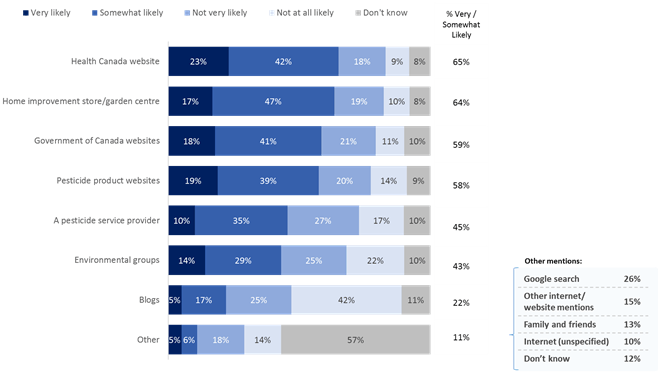
Q22. If you were looking for information about pesticides, how likely would you be to consult the following sources?
[SINGLE CODE PER ATTRIBUTE]. Base: All Respondents (n=2,015)
Those who indicate they are 'not very' or 'not at all likely' to consult the 'Health Canada website' (27%) include:
And, those who say they:
Those more likely to say they are 'very' or 'somewhat likely' to consult a 'home improvement store/garden centre' (63%) include:
And, those who say:
Respondents were also asked if they had consulted a list of information sources. Just over a third (36%) of respondents have looked for information on pesticides 'on the internet.' Not surprisingly, given that respondents indicated they are most likely to consult a 'home improvement store/garden centre,' three in 10 (29%) say they have consulted a 'garden centre' and another two in 10 (19%) have consulted a 'hardware store'. One in 10 (10%) say they have consulted a 'pest control company/pest control operator' and a similar proportion (8%) say they have consulted 'a friend.' Few have ever consulted a doctor (4%) and almost half of respondents (46%) have never consulted any of the sources presented.
Figure 12: Ever Looked for Information on Pesticides From Any of the Following Sources
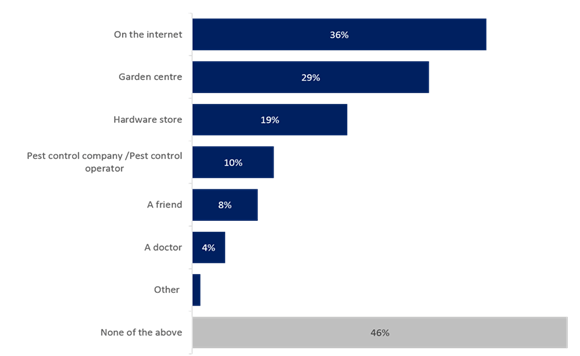
Q20a. Have you ever looked for information on pesticides from any of the following sources? [MULTICODE]
Labels not shown for 3% and lower. Base: All Respondents (n=2,015)
Those more likely to say they have looked for information 'on the internet' (36%) include:
And, those who say they:
Among a list of websites, those who looked for information about pesticides on the internet, two thirds (65%) went to 'Google.' Four in 10 (48%) went to a 'pesticide product website' and a quarter (24%) to the 'Health Canada website' or an 'environmental group's website.' Only two in 10 (20%) went to the 'Government of Canada website' and roughly half as many (12%) went to a 'municipal government website. Fewer than one in 10 visited 'Youtube' (7%), 'blogs' (6%), or 'Facebook' (5%).
Figure 13: Where Looked for Information about Pesticides on the Internet

Q20b. You indicated you have looked for information about pesticides on the Internet. From the following list, please indicate which websites you have visited? [MULTICODE] Labels not shown for 3% and lower. Base: All who looked for information about pesticides on the internet (n=707)
Those most likely to say they visited the 'Health Canada website' include those who say they:
When asked what subjects they sought information about when consulting these sources, two thirds (65%) say they searched for information on 'safe-use' and six in 10 searched for 'health related information.' Just over half (56%) looked for 'how to get rid of pests' and half (48%) searched for 'environmental impact information.' Roughly four in 10 (38%) searched for information on 'chemical content' or 'product selection information' (37%). Three in 10 (28%) looked for information on 'how to identify pests.'
Figure 14: What Would Be Most Liekly to Search for on the Internet About Pesticides
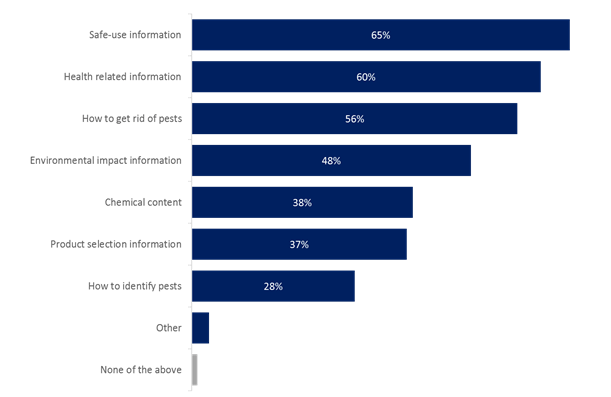
Q21. If you were to look for information about pesticides, what would you be most likely to search for? [MULTICODE] Labels not shown for 3% and lower. Base: All who looked for information about pesticides on the internet (n=707)
Older respondents are more likely to have sought information on the internet about all of the subjects listed except for 'health related information' and 'how to identify pests.' Residents of rural areas (56%) are more likely than residents of suburban zones (45%) to look for information about 'environmental impact', as are women (54% vs men, 41%) and those in households earning an annual income of less than $40K (58%) compared to those in households with annual incomes of $60k to less than $100k (45%) and $100K or more (43%).
Those more likely to have looked for information on the internet about 'health related information' (60%) include those who say they:
Those more likely to have looked for information on the internet about 'how to get rid of pests' (56%) include those who say they:
Those most likely to have looked for information on the internet about 'environmental impact' (48%) include those who say they:
Those most likely to have looked for information on the internet about 'chemical content' (38%) include those who say they:
When asked to rate a series of potential spokespeople or organizations on a scale of one to seven, where one means 'believe none of what they say' and seven means 'believe most of what they say' about the risks of pesticides, respondents are most likely to rate the 'Royal College of Physicians and Surgeons' as believable (42% providing a rating of 6 or 7). The Canadian Cancer Society is seen as next most believable source with nearly as many (38%) offering a rating of either six (18%) or seven (20%). A similar proportion overall (37%) rate 'A health Canada Scientist' as either a six (23%) or a seven (14%).
Overall, the 'David Suzuki Foundation' (31%) receives similar positive ratings to a 'medical doctor' (29%) and a Health Canada Spokesperson (27%) each with around three in 10 offering a rating of either a six or a seven, however, respondents are nearly twice as likely to rate the 'David Suzuki Foundation' as a seven (16% vs 9% for a Health Canada Spokesperson). Conversely, a higher proportion of respondents also rate the 'David Suzuki Foundation' as a one, two or three (24%) indicating they 'believe none of that they say', compared to only 17% who provide a similarly low rating for a Health Canada Spokesperson.
Just two in 10 rate the “Canadian Environmental Law Association' (21%) and 'The Health Minister' (20%) as believable (six or seven on the scale). 'A university professor is perceived to be believable by only sixteen percent of respondents. Finally, 'a pesticide manufacturer spokesperson' is seen as the least believable with only five percent offering a rating of six (2%) or seven (3%). Almost half (47%) of respondents rate this source as either a one (25%) or a two (22%).
Figure 15: Believability of Sources
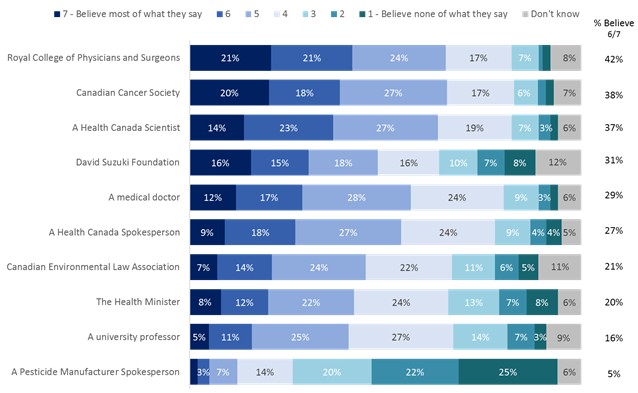
Q11. Thinking about the various people or organizations who may provide information about the risks of pesticides, to what extent do you think you can believe what they say? [SINGLE CODE PER ATTRIBUTE]. Labels not shown for 2% and lower. Base: All Respondents (n=2,015)
In all cases, except for 'a university professor' and the 'David Suzuki Foundation' respondents who say they are 'very' or 'somewhat' confident that Health Canada's PMRA protects health and the environment as per the Pest Control Products Act are more likely to rate all the people or organizations presented as either a six or a seven, compared to those who say they are 'not very' or 'not at all confident.'
Also, women are more likely than men to offer a rating of six or seven to the Canadian Cancer Society (41% vs men, 36%), the David Suzuki Foundation (34% vs men, 28%), the Health Minister (23% vs men, 16%), and the Canadian Environmental Law Association (25% vs men, 18%).
Those most likely to rate the Royal College of Physicians and Surgeons as believable (six or seven) include those who live in households earning $100K or more annually (47%), compared to those earning less than $40K (37%) and those who say they have ever looked for information on pesticides (45%), compared to those who say they have not (38%).
Similarly, income and having looked for information on pesticides in the past have an impact on ratings of either six or seven for the Canadian Cancer Society. Those living in households earning $100K or more (43%) are more likely than those earning less than $40K (36%) to offer this rating, as are those who say they have ever looked for information on pesticides (42%), compared to those who have not (34%). When it comes to the believability of the Canadian Cancer Society, age also plays a role. Those who offer a rating of six or seven are more likely to include respondents aged 55 years and older (41%) and those 35 to 54 years of age (39%), compared to 18 to 34 year olds (34%).
Those more likely to give the 'David Suzuki Foundation' a rating of six or seven also include those aged 35 to 54 year olds (33%) and those aged 55 years or older (34%), compared to 18 to 34 year olds (25%) and, those who say they:
Those most likely to give a 'Health Canada Scientist' a rating of six or seven also include those who say they:
Those more likely to give the 'Health Minister' a rating of six or seven also include 18 to 34 year olds (23%), compared to 35 to 54 year olds (19%) and respondents living in households that earn less than $40K annually (23%) or between $40K and less than $60K (24%), compared to those in households earning $100K or more (17%).
The two most frequent unprompted answers when asked where they would first look for information on pesticides were Google and Government in general. Other sources that were spontaneously mentioned included environment groups' websites, “neutral third parties” (which were hard to identify) and, with strong reservations, companies who sell or manufacture the products.
If looking for information through Google, participants mentioned that they would simply do a general search using keywords. Keywords mentioned included:
Beyond the keywords, it often proved difficult to specify how they would identify what would be a credible source of information when presented with thousands of entries in their Google search. Some said they would pick the first few items of the list, while others said they would start with identifying whether it was a government, company or environmental website to “anticipate their biases”.
The Canadian government that was most often listed as a key source of information within the more general “government” category identified by participants. They would either look for federal government online information by searching with keywords that included the Government of Canada, or they would go to a federal agency website. Health Canada was mentioned by name as a direct source, with others pointing to ministries or departments (including provincial ones) dealing with agricultural and environmental issues, without necessarily knowing the exact name of those departments.
Companies, either manufacturers or sellers, were seen as practical sources of information. Participants would simply ask sales representatives in stores, read labels or go to the company's website for more information. While practical and often consulted, these sources were nevertheless seen as lacking credibility to provide accurate information on the risks posed by their products. They were used to get the basic facts necessary to use a product around the house in the most efficient manner.
It was difficult for participants to point to the most credible sources of information, although it was clear that companies that manufacture the products were not credible at all according to participants, except for a couple of individuals in Toronto. They were seen as profit seekers that would not prioritize the health and safety of humans and animals. While the Canadian government was identified as an obvious source of information, as explained above, participants were divided regarding its overall credibility. Most participants in Toronto said they would trust it, at least to a certain extent. Those in Montreal were less likely to agree, expressing more cynicism towards governments at all levels.
If information were to emanate from the Government of Canada, participants across all locations insisted that scientists needed to be involved and not just politicians. Participants who felt that the Health Minister could be a spokesperson also mentioned that she needed to be backed by scientific data or scientists.
Environmental groups, starting with the 'David Suzuki Foundation' in Toronto and 'Equiterre' in Montreal, were seen as credible sources of information, but mostly for one side of the equation. Aside from a handful of individuals who actively sought out information from these organizations, most others felt that they would trust these groups to inform them of the risks, but that they would seek information from other sources as well in order to get a fuller, or more balanced, picture of the pros and cons of using a given product available on the market.
Medical associations and groups were seen as mostly credible, starting with the Canadian Cancer Society, although some participants in Montreal expressed some doubts regarding the credibility of medical doctors because of recent controversies involving doctors and the “Collège des médecins”. Finally, consumer groups were seen as credible sources of information when prompted, but were not mentioned on a spontaneous basis.
While awareness that Health Canada assesses the safety of pesticides before deciding whether they can be registered for sale and use in Canada is low, prior to being informed of Health Canada's role, seven in 10 respondents attribute responsibility for pesticide regulation to the federal government, most believe it falls under the purview of Agriculture and Agri-food Canada. Older men with higher incomes are most likely to attribute this role to the federal level. Older respondents with higher incomes are more likely to have been aware prior to the survey that Health Canada plays this regulatory role.
Knowledge of how regulatory decisions are made is very low. Half of respondents offer rate their knowledge as either a one or two out of seven.
The majority of respondents admit that they are not knowledgeable about the pesticides regulatory process in Canada. As much as eighty-six percent of respondents say they are not very (45%) or not at all (41%) knowledgeable about the process.
Figure 16: How Knowledgeable About Pesticides Regulatory Process in Canada
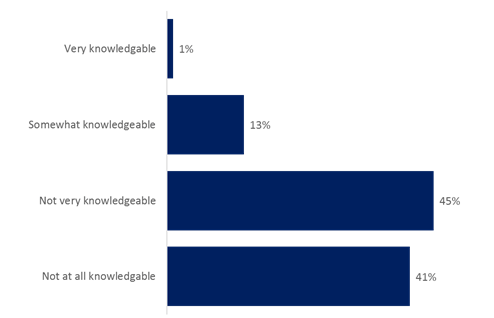
Q8. Overall, how knowledgeable are you about the pesticides regulatory process in Canada? [SINGLE CODE]
Base: All Respondents (n=2,015)
Those more likely to indicate they are 'very' or 'somewhat' knowledgeable include:
And, those who say they:
Respondents were asked to rate their awareness (prior to completing the survey) that Health Canada assesses the safety of pesticides before deciding whether they can be registered for sale and use in Canada on a scale of one to seven, where one means 'not at all aware' and seven means 'completely aware.' Awareness that Health Canada plays this role is low with only three in 10 (31%) offering a rating of five, six or seven compared to nearly half (44%) who offer a rating of one, two or three. Two in 10 (18%) respondents offer a neutral rating of four out of seven and seven percent say they don't know if they are aware.
Figure 17: Agree/Disagree: 'Health Canada assesses the safety of pesticides before deciding whether they can be registered for sale and use in Canada.'

Q12. Before today, to what extent were you aware that Health Canada assesses the safety of pesticides before deciding whether they can be registered for sale and use in Canada? [SINGLE CODE]. 'Don't know' response not shown. Base: All Respondents (n=2,015)
Those more likely to say they were previously aware (providing a rating of 5, 6 or 7) that Health Canada 'assesses the safety of pesticides before deciding whether they can be registered for sale and use in Canada' include:
And, those who say they:
When asked to select from a list which level (or levels) of government are responsible for regulating pesticides in Canada, six in 10 (62%) choose the 'Federal government.' A third (34%) say this falls under the provincial government's jurisdiction while two in 10 (20%) select 'municipal government.' Two in 10 (18%) say they 'don't know.'
Those who selected the 'federal government' were asked which departments are responsible. Three quarters (73%) of responses mentioned 'Agriculture and Agri-food Canada' while just over half (55%) mentioned 'Health Canada'. A third (34%) of mentions related to 'Environment and Climate Change.'
Similarly, those who chose 'provincial government' were asked which departments are responsible for regulating pesticides. A majority of responses (67%) indicate the Ministry of Agriculture and nearly as many (64%) mentioned the Ministry of the Environment. Almost half of mentions (46%) related to the Ministry of Health.
Figure 18: Level of Government Responsible for Regulating Pesticides in Canada
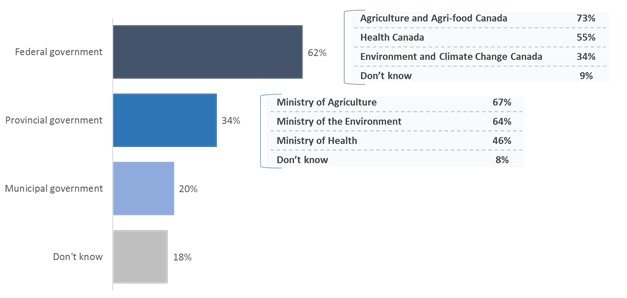
Q9a. Which level (or levels) of government do you think are responsible for regulating pesticides in Canada? [MULTICODE] Base: All Respondents (n=2,015) / Q9b. And which ... department(s) do you think is/are responsible for regulating pesticides in Canada? - Federal government [MULTICODE] Base: All who think the Federal government is responsible for regulating pesticides in Canada (n=1,257) / Q9b. And which ... department(s) do you think is/are responsible for regulating pesticides in Canada? - Provincial government [MULTICODE] Base: All who think the Provincial government is responsible for regulating pesticides in Canada (n=696)
Those more likely to say that the Federal Government is responsible for regulating pesticides in Canada include:
And those who say they:
Those most likely to say that they 'don't know' which level of government is responsible for regulating pesticides in Canada include:
Understanding about the regulatory decision-making process is very low. Only one in ten (11%) indicate they have a high of understanding of the process (providing a rating of five, six or seven on a scale of one to seven where one means 'do not understand at all' and 7 means 'high level of understanding'). Nearly three quarters (73%) of respondents indicate they do not understand the process (offering a rating of one (33%), two (20%) of three (20%)).
Figure 19: Level of Understanding About How Pesticides Regulatory Decisions Are Made

Q10. What is your level of understanding about how pesticide regulatory decisions are made? [SINGLE CODE]. Base: All Respondents (n=2,015)
Due to low levels of understanding overall, there is not sufficient sample among those who indicate a higher level of understanding (offering a rating of 5,6,7) to show clear demographic and attitudinal differences. However, an analysis of those who offer a rating of five, six or seven shows they include men (14%), compared to women (9%) and younger respondents aged 18 to 34 year olds (15%), compared to those aged 35 to 54 years old (10%) and aged 55 years or older (10%).
And, those who say they:
When asked to indicate which sources (from a list presented) are considered when a pesticide regulatory decision is made, nearly half of respondents say 'academic/peer-reviewed studies' are considered (45%). Just over a third (35%) select 'industry-sponsored studies' and nearly three in 10 (27%) say 'industry sector priorities.' Just two in 10 (20%) say that public opinion is considered. One in 10 (8%) say 'none of the above' and a third (33%) say they 'don't know.'
Figure 20: Information Considered when a Pesticide Regulatory Decision is Made

Q13. What information is considered when a pesticide regulatory decision is made? [MULTICODE]. Base: All Respondents (n=2,015)
Respondents who selected any of the options (except for 'none of the above' or 'don't know') are more likely to have seen, read or heard something about pesticides in the past three months, to be aware that Health Canada assesses the safety of pesticides before deciding whether they can be registered for sale in Canada and to have ever looked for information about pesticides.
Those most likely to say 'academic/peer-reviewed studies' are consulted include:
And those who say they are 'somewhat' or 'very' confident that Health Canada's PMRA protects health and the environment as per the Pest Control Products Act (55%), compared to those who are not very or not at all confident (41%).
Those most likely to say 'industry-sponsored studies' are consulted include:
Those most likely to say 'industry sector priorities' are consulted include:
Those most likely to say 'public opinion' is consulted include:
And, those who say they:
Among a list of products presented, half (51%) of respondents say that 'weed killer (herbicides)' are regulated as pesticides in Canada. Four in 10 (41%) say that 'insect repellants/bug spray' are regulated. A third (33%) say that 'ant traps (insecticides)' are regulated as pesticides and nearly as many (31%) say the same is true for 'swimming pool chemicals' and 'treated wood' (30%). A quarter (25%) say that 'pet flea collars' are regulated and just sixteen percent say the same for 'bug zappers.' Four percent say 'none of the above' are regulated. Just over a third (36%) say they 'don't know' if any of the products listed are regulated as pesticides in Canada.
Figure 21: Products Regulated as Pesticides in Canada
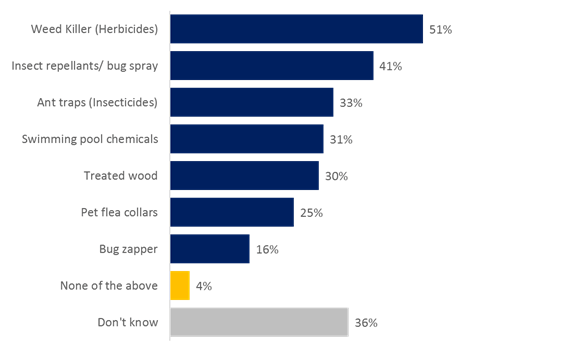
Q7. Which of the following products, if any, are regulated as pesticides in Canada? [MULTICODE]. Base: All Respondents (n=2,015)
Respondents who say any of the products are regulated as pesticides in Canada include respondents aged 55 years or older (except for 'bug zappers') and those who say they:
In the case of 'weed killer (herbicides),' 'insect repellants/bug spray,' and 'treated wood,' men are more likely to say they are regulated.
Those who 'don't know' whether any of the products is regulated as a pesticide in Canada include:
And, those who say they:
Focus groups helped in putting the results of the quantitative phase of research under a different light. They added some texture to survey findings showing that while Canadians feel that the country's pesticide and pest control product regulation system is good, they at the same time don't know very much, if anything at all, about how this system works and who leads the way in regulating and registering pesticides. However, most participants instinctively believed, or hoped, that the federal government led the way since pesticides crossed provincial borders.
They liked to think that common guidelines were applied across Canada, although many were not convinced that it was the case with all products. As to which government department should be responsible, views were split between Health Canada, Agriculture and Agri-Food Canada and Environment Canada. Participants felt that some form of cross-department collaboration was probably a good idea since pesticides affected human health, as well as animal health and the environment more generally.
Most participants agreed that individuals shared some of the responsibility for ensuring that pesticides and pest control products are used safely in Canada. However, because most of their concerns related to commercial use or production, they did not think that they had the power to do much on their own. While they also felt that pesticide-makers or commercial users had a responsibility in ensuring that products were produced and used safely, few participants trusted them to make the right decisions without strong government intervention.
Participants showed that their feeling of safety rests mostly on a general belief that various levels of governments, starting with the federal government, probably do a good job at protecting them and their families. They may not know precisely how they are protected but they feel mostly secure because they do not hear much about serious incidents or problems and believe that the Canadian government is better than the government of most other countries, including the United States, at protecting its citizens. Participants were especially convinced of the superiority of Canada's standards and practices compared to countries in Asia, with China coming to mind first. They felt that these countries would likely not have much control over the products that were used by the farming industry.
On the other hand, there was a clear sense among most participants that Western European countries, starting with France, probably have more stringent pesticide regulations in place and do a better job at protecting their citizens and their environment. This belief rarely stemmed from knowledge of specific examples, but rather from a general sense that these countries put a higher priority on smaller scale agricultural production at a local level and have more interventionist governments that are more likely to impose tight controls on pesticide use.
Once again without much hard evidence to back their claims, most participants felt that pesticide use and regulations have improved in recent years, although a few of the more cynical individuals in Montreal felt that things had not improved or may have in fact gotten worse. Older participants could relate to incidents earlier in their lives when themselves or people they knew used dangerous chemicals or products in a manner that would be deemed totally unacceptable nowadays: “I remember how we used to spray weed-killing products using these big canisters without any gloves or masks. You can't, and you wouldn't, do that anymore”. To them, such examples were clear signs that things had improved over the years.
Others felt that the situation was probably better based on their general belief that our collective understanding of what was good or bad for human health and the environment had improved over time, fueled by more advanced scientific knowledge and the banning of substances and practices that were once deemed acceptable.
Given the low awareness of Health Canada's regulatory role and low understanding of the decision-making process, it is not surprising that views of the PMRA effectiveness are mixed. Half of respondents offer moderated agreement with a series of statements about how the PMRA is doing in carrying out its key responsibilities. The vast majority are unaware that the PMRA consults with the public as part of the process; only three percent know how to participate in the decision-making process.
Confidence is that Health Canada's PMRA protects health and the environment as per the Pest Control Products Act is high with six in 10 reporting at least some level of confidence. That said, a quarter say they are not very confident.
Respondents tend to say that Canada's pesticide regulatory system is the same as or worse than that of the EU but are more likely to say that Canada's system is the same or better than the U.S.'s system.
When asked to rate their agreement on a seven-point scale where seven means 'completely agree' and one means 'do not agree at all' with a series of statements about the effectiveness of Health Canada's PMRA, views are mixed. Few respondents offer ratings of strong agreement (six or seven) or strong disagreement (one or two) with roughly half (ranging from 47% to 50%) offering ratings of three for or five in every case.
Figure 22: Agree/Disagree
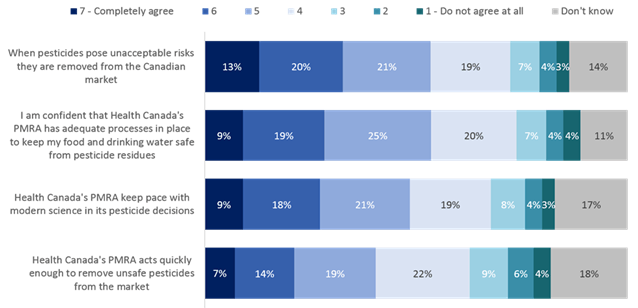
Q17. Using a scale from 1 to 7 where '1' is not at all and '7' is completely, to what extent do you agree with each of the following statements? [SINGLE CODE PER ATTRIBUTE]. Base: All Respondents (n=2,015)
Respondents more likely to completely agree (providing a rating of 6 or 7) with each of the statements include those aged 55 years or older and those who say they:
Despite low awareness of Health Canada's role in regulating pesticides through the PMRA and mixed views of the PMRA's effectiveness, awareness of the PMRA's responsibilities is relatively high regarding 'making sure a product meets health standards (67%), 'requiring specific warning statements on product labels' (64%), and 'making sure a product meets environmental standards' (64%). Roughly six in 10 are aware that the PMRA is responsible for 'pulling unsafe products from the shelves' (61%), 'setting safety standards for companies to follow' (59%), 'Reviewing products on the market on an ongoing basis to make sure they continue to meet safety standards' (58%) and 'making sure products contain the ingredients they say they do' (57%).
Four in 10 say they are responsible for 'ensuring products are not contaminated' (43%) and 'making sure a product is effective for controlling pests' (42%). Just three in 10 (29%) say the PMRA is responsible for 'reviewing product advertising' and two in 10 (19%) say they 'don't know'.
Figure 23: Tasks Health Canada's PMRA is Responsible for with Regards to Pesticides
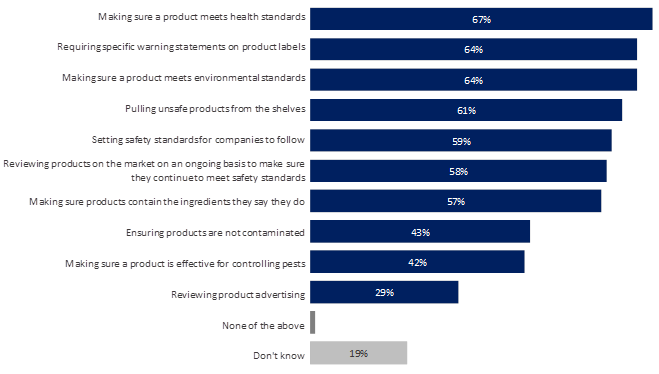
Q16. Which tasks, if any, do you believe Health Canada's PMRA is responsible for with regards to pesticides? [MULTICODE]. Base: All Respondents (n=2,015)
Those more likely to be aware of any of the responsibilities include women and older respondents, with awareness increasing with age, and those who say they:
Those who 'often' or 'sometimes' use pesticides are more likely to believe that the PMRA is responsible for 'Requiring specific warning statements on product labels' (69% vs rarely/never use, 63%), 'Making sure a product meets environmental standards' (69% vs rarely/never use, 63%), 'Making sure products contain the ingredients they say they do' (63% vs rarely/never use, 56%), and 'Making sure a product is effective for controlling pests' (47% vs rarely/never use, 41%).
Respondents were asked if they were aware that Health Canada' PMRA consults with the public on decision related to pesticides and whether or not they know how to participate in the pesticides decision making process. In both cases, awareness is very low. Nine in 10 respondents (87%) are not aware that the PMRA consults with the public and ninety-six percent are not aware of how to participate.
Figure 24: Aware that Health Canada's PMRA Consults with the Public on Decisions Related to Pesticides?

Q18. Were you aware that Health Canada's PMRA consults with the public on decisions related to pesticides? [SINGLE CODE]. Base: All Respondents (n=2,015)
Around a quarter of respondents (27%) who are aware that Health Canada's PMRA consults with the public on decisions related to pesticides indicated they know how to participate in the pesticides decision making process. Within the context of the total survey sample (n=2,015), this represents four percent of respondents who know how to participate in this process.
Figure 25: Know How to Participate in the Pesticides Decision Making Process Carried Out By Health Canada's PMRA?
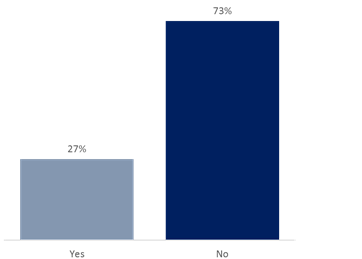
Q19. Do you know how to participate in the pesticide decision making process carried out by Health Canada's PMRA?
[SINGLE CODE]. Base: All who are aware that Health Canada's PMRA consults with the public on decisions related to pesticides (n=270)
Those more likely to be aware that Health Canada's PMRA consults with the public on decisions related to pesticides includes:
Among those who are aware that Health Canada's PMRA consults with the public on decisions related to pesticides, those who are more likely to know how to participate in the decision making process include:
Despite this lack of awareness of the PMRA's public consultation process, six in 10 (57%) respondents are either 'very' (8%) or 'somewhat' (49%) confident that Health Canada's PMRA protects health and the environment as per the Pest Control Products Act. That said, a quarter (23%) are 'not very confident' and another one in 10 (7%) are 'not at all confident'.
Figure 26: Confidence in Health Canada's PMRA
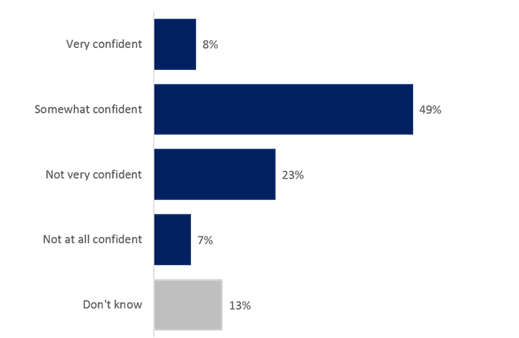
Q14. How confident are you that Health Canada's PMRA protects health and the environment as per the Pest Control Products Act? [SINGLE CODE]. Base: All Respondents (n=2,015)
Those more likely to say that they are 'very' or 'somewhat' confident that Health Canada's PMRA protects health and the environment as per the Pest Control Products Act include:
Conversely, those who indicate they are 'not very confident' that Health Canada's PMRA protects health and the environment as per the Pest Control Products Act include:
In addition, those who responded 'don't know' when asked the extent to which they were confident that Health Canada's PMRA protects health and the environment as per the Pest Control Products Act include:
Respondents were asked to compare Canada's pesticide regulatory system to that of the European Union (EU). Six in 10 respondents (57%) say that our system is the 'same as' the EU's and another quarter (26%) say that Canada's system is 'worse than' than that of the EU. Only two in 10 (17%) say that Canada's pesticide regulatory system is 'better than' that of the EU.
When asked why they say Canada's system is worse, three in 10 (30%) indicated that 'they have a better regulatory system' with reference to 'enforcement.' Other mentions include '(Canada) poor/worse/lack of regulatory systems,' (10%), 'Europe is more environmentally friendly' (9%), 'Europe is more focused on people/health/safety standards' (5%), and 'Europe is more progressive/advanced' (4%). Those who say Canada's system is better mention 'Canada has a better regulatory system/enforcement' (15%), '(European Union) poor/worse/lack of regulatory systems' (4%), and 'in Canada, more based on research/scientific data/better experience' (4%).
Figure 27: How Canada's Pesticide Regulatory System Compares to the European Union
Compared to the European Union, Canada's pesticide regulatory system is…
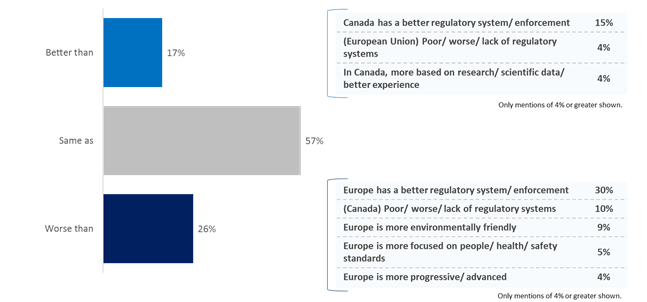
Q15a. [European Union] Based on your current level of knowledge, how do you think Canada's pesticide regulatory system compares to each of the following? [SINGLE CODE] Base: All Respondents (n=2,015) / Q15b. Why do you say that? [OPEN RESPONSE] Base: All who think that the pesticides regulatory system in Canada is BETTER THAN the European Union (n=341) / Q15b. Why do you say that? [OPEN RESPONSE] Base: All who think that the pesticides regulatory system in Canada is WORSE THAN the European Union (n=533)
Those more likely to think that Canada's pesticide regulatory system is comparatively better than the European Union include:
Those more likely to think that Canada's pesticide regulatory system is comparatively worse than the European Union include:
And those more likely to think that Canada's pesticide regulatory system is the same as than the European Union include:
Respondents were also asked to compare Canada's pesticide regulatory system to that of the United States (U.S.). Half of respondents (50%) say that our system is the 'same as' the United States and another four in 10 (39%) say that Canada's system is 'better than' the U.S.'s. Only one in 10 (11%) say that Canada's pesticide regulatory system is 'worse than' that of the U.S.
Those who say Canada's system is better mention 'Canada has a better regulatory system/enforcement' (30%), 'U.S. is less regulated/poor regulatory system' (21%), and 'U.S. has strong/influential lobbyists/government lobbying system' (7%) and 'U.S. has more pesticides/herbicides available in stores' (7%). When asked why they say Canada's system is worse, seven percent indicated that 'U.S. have a better regulatory system' with a reference to 'enforcement' (7%).
Figure 28: How Canada's Pesticide Regulatory Process Compares to the United States
Compared to the United States, Canada's pesticide regulatory system is...
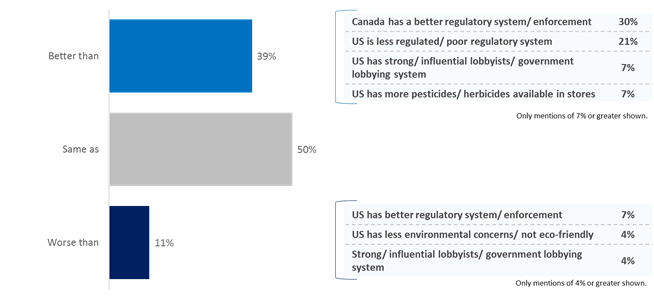
Q15a. [United States] Based on your current level of knowledge, how do you think Canada's pesticide regulatory system compares to each of the following? [SINGLE CODE] Base: All Respondents (n=2,015) / Q15b. Why do you say that? [OPEN RESPONSE] Base: All who think that the pesticides regulatory system in Canada is BETTER THAN the United States (n=789) / Q15b. Why do you say that? [OPEN RESPONSE] Base: All who think that the pesticides regulatory system in Canada is WORSE THAN the United States (n=215)
Those more likely to think that Canada's pesticide regulatory system is comparatively better than the United States include:
Those more likely to think that Canada's pesticide regulatory system is comparatively worse than the United States include:
And those more likely to think that Canada's pesticide regulatory system is the same as than the United States include:
Focus groups were used to provide an in-depth complement to quantitative findings and to allow for direct testing of a series of messages that may be used to communicate with Canadians regarding pesticides and pest control products use and regulations in Canada. As such, six different series of statements were tested to measure participants' views as to their relevance, clarity and impact. Results for each series of statements are evaluated in turn in this section.
Overall, the messaging tested in the four groups was well received. Most participants, especially in Toronto, were reassured by what they read and felt that it provided good information, even if they often would have liked to get more details or more factual information regarding how Health Canada fulfilled its duties. While Montreal participants remained somewhat less positive in their assessment of the messages, they nevertheless saw them as important and useful in general.
A first series of more general statements presenting general information regarding Health Canada's role in regulating and registering pesticides and pest control products was presented to participants. These included:
Participants mostly agreed that the statements, albeit general in nature, felt reassuring. They liked that the information talked about protecting Canadians' health and the (or their) environment. The subtle difference between statements using the wording “the environment” as opposed to “their environment” was not noticed by participants.
By identifying Health Canada and the Pest Control Products Act as the key body and piece of legislation that were meant to protect Canadians, these statements taken together confirmed what many participants “felt”, but did not know: that there are indeed legal safeguards and actual people in place to enforce rules and regulations. Health Canada was seen as a legitimate agency to regulate pesticides in Canada, although some mentioned that they would also like to see other departments, starting with Environment and Climate Canada and Agriculture and Agri-Food Canada, be involved as well because of their knowledge of risk factors outside of human health. Some in Montreal and Toronto questioned whether animals were taken into consideration as part of the work done by Health Canada. They did not view protection of the environment as being necessarily inclusive of animal welfare and would have liked to see a more direct statement to that effect.
The inclusion of “scientists” in the second statement was deemed essential by most participants. It made it clear to them that the evaluation process was completed by someone with the proper scientific knowledge to properly assess the safety of products that were used in Canada. It also confirmed that these scientists were working for Health Canada and not for the industry. If the word scientist were not included, many said that they would not necessarily assume that the evaluation would be done by a scientist, but rather felt that it opened the door to having unqualified individuals completing the tasks using basic “checklists”.
A few participants, especially in Montreal, shared their cynicism with regards to those general statements. They did not disagree with their content, but felt that overall, this did not provide specific information as to how the government was protecting them. The statements felt empty or vague to those participants, leaving them unconvinced.
A second series of statements, this time presenting pre-market statements about the regulation and registration of pesticides and pest control products, was presented to participants. These statements were as follows:
Once more, these statements were well received overall, although a few elements generated negative comments or raised questions. The main message delivered by these statements, as understood by participants, was that Health Canada ensures that pesticide products used in Canada are safe. In that vein, participants especially liked the second statement because it clearly laid out that Health Canada would not register any product that could harm human health or the environment. This was viewed as a strong and reassuring statement by most participants.
The use of the word “value” as part of the first statement in English raised a lot of questions. To some it seemed to refer to the commercial value of the product, which made them think that maybe the potential for financial gains would play a role in how stringent the evaluation would be. They did not like that. In French, “it has value” was translated into “a sa raison d'être”, which sat better with participants because it was not associated with money or profits. However, a few participants in Montreal nevertheless asked whether the government would consider economic benefits of job losses in its decision to ban a specific product. They did not want such considerations to play a significant role when the health of Canadians is at play.
The use of the word “or” rather than “and” to separate the words health and environment in the first two statements was also spontaneously noticed by many participants. They felt that it may suggest a choice between a focus on human health or a focus on the environment rather than a continuous focus on both aspects. They preferred to see “and” in the statements, like it was used in the first series of general statements. Also, the notion of “high” safety standards left some participants wanting. They felt this was somewhat vague and wanted to see a stronger, more precise term used. Many also wanted to know who established those standards and how they were decided upon.
Some participants mentioned that the word “concerns” (préoccupations in French) may not be strong enough in the context of the first statement. They felt it leaved the door open to wide ranging interpretations. They preferred the wording used in the second statement: no harm [….] will result from its use. As discussed in the previous section of the general messaging lines, participants once more stated that they would like to see a specific mention of animal health as part of these statements. They worried that animals would not be taken into account when evaluating products and setting standards for sale or use.
The distinction between pest control, as used in the third statement, and pesticides, as used in the first two, was raised once again in both languages. The mention of pest control (anti-parasitaire in French) was seen to dilute the meaning of the third statement because it sounded “nicer” than pesticides. In French, the word “homologué” (registered) left some participants confused. They did not understand what it meant and a few mentioned that while they did understand it, they doubted that many fellow citizens would.
A third series of statements, this time presenting post-market statements about the regulation and registration of pesticides and pest control products was presented to participants. These statements were:
Reactions to this group of statements were mostly positive overall, but generated more criticisms than previous statements shown. On the one hand, participants appreciated the fact that Health Canada was performing regular checks on products that were already sold in the marketplace. They were reassured to know the process was not simply ending once a product was approved for sale but that its use and sale remained contingent on periodical reviews and checks on incidents. It was therefore not the essence of the messages that generated most criticisms, but the wording used.
When asked which of the first two statements was stronger, most participants chose the first one. It was seen as more direct, more incisive. The second statement was clear, but did not suggest that this was actually acted upon. It also lacked the word “scientific”, which participants once again viewed as essential to reassure Canadians.
One of the criticisms focused on the use of the term “regular” (“périodique” in French) to describe the extent of post-market verifications conducted by Health Canada. While some were positively impressed to know that Health Canada continued its verifications even after a product was registered, many expressed reservations, stating that “regular” could include a wide-range of possibilities. They preferred to think that verifications were held continuously, or were ongoing, rather than just “regular”. The mention of regular verifications triggered a desire to see actual numbers on the part of participants, whereas many felt using the words ongoing or continuous did not raise this issue because it did not suggest that monitoring stopped for any length of time. Those who specified what they viewed as an acceptable time gap between inspections had very high expectations, talking in months rather than years.
Another sticking point for many participants was the reference to pesticide “incidents” in the third statement. The word raised a red flag for some participants. It immediately brought to mind major issues with commercial pesticide use that affected human health and the environment rather than smaller accidents caused by individuals who may have misused a product at home or at work. This reflected their aforementioned top-of-mind views regarding pesticides, which were mostly related to agricultural or large-scale use. As a result, some felt that the mention of incidents pointed to the weakness of the initial regulations since there should not be major problems if the products had been previously approved for use. It made them feel as though the initial assessments may be too weak to prevent major problems from occurring in the first place. They felt this statement made Health Canada sound reactive rather than proactive in protecting Canadians' health and the environment.
However, further probing showed that participants were in fact glad to know that Health Canada paid attention to incidents. This was indeed expected, even seen as a given. The fact that this statement was tested after a series of messages that assured participants that all steps were taken to ensure the safety of products may have also contributed to the more negative spontaneous reactions to this idea. Indeed, some participants directly referred to previous statements on pesticide safety to justify their negative feedback: “We are told that only safe products are used or sold and then I read that Health Canada is investigating incidents… Are they safe or not?”.
Finally, the use of the word “modern” generated cynical reactions from some participants. It seemed too vague and far-reaching to them, some stating that standards from multiple decades ago could qualify as being modern. They would feel safer knowing that Health Canada followed state of the art standards using the latest scientific knowledge and procedures rather than modern ones since such standards probably evolved very rapidly. Inclusion of the terms scientific or scientists was once more brought up as essential to strengthen the messages and provide deeper reassurance to Canadians.
A fourth series of statements on compliance with rules and regulations was presented to participants. These included:
Comments on these statements closely reflected what was heard with regards to the previous set on post-market evaluation. On the one hand, participants were happy to know that Health Canada stayed appraised of developments after a product was approved for use in Canada and that it also ensured that only registered products were used. It was once more deemed reassuring, comforting. On the other hand, many participants were somewhat confused by a few elements contained in these statements.
The second statement garnered more positive reactions than the first one despite their similitude because it clearly identified Health Canada as being responsible for investigating and inspecting. However, the same criticism presented above was raised concerning the use of the word “regular” to qualify the frequency of investigations and inspections. This raised questions over the length of time during which no investigations or inspections too place.
The first statement was seen as vague, or passive. Participants felt it did not say anything regarding who would do these tasks this nor how they could do it efficiently and thoroughly. However, a few participants liked to see that regulations “helped ensure” that only registered products were used in Canada, as opposed to merely saying that they were conducted “so that” only registered products were used in Canada. It sounded stronger, more assertive.
The overall idea behind the third statement also generated some positive views because it provided information on an education mandate for Health Canada beyond regulation and enforcement. However, it was also clear that most participants did not have a clear understanding of what the education component meant or whom it was meant for. They questioned whether this education component targeted members of the general public, youth, agricultural producers or industry members. The level of credibility, and the perceive ambitiousness, attached to the statement also depended on whom it was meant for.
The end of the first two statements, asserting that Health Canada ensured that products are used according to label directions, generated a lot of questioning across all four groups. Most participants did not understand how this was doable unless Health Canada actually followed customers to see how they used products, something they did not believe could happen. When thinking about the implications of this statement, some feared that the government would intrude on their privacy to “spy” on how they use pesticide and pest control products at home. They wanted an explanation regarding the means through which this could be achieved. Respondents who discussed how this could apply to commercial use were also somewhat confused regarding how this could be monitored and especially, enforced.
Finally, participants were shown a series of statements regarding neonicotinoids to gauge their awareness of the issue and their reaction to the ideas presented:
Although only a few participants spontaneously raised concerns over the health of bees during the earlier parts of the discussions, most participants across all groups said that they had heard something about this issue once they had read this series of three statements. Participants differed on what they had heard or when, but the recent Zika outbreak in Florida and the subsequent use of pesticides that hurt bees was the most common souvenir for participants. Even among those who did not recall specific news coverage regarding the health of bees, it was clear that this was understood to be a serious concern in Canada and across the world in general. A few participants could even describe in a lot of details how the reduction in bee populations could impact human, vegetable and animal lives.
Aside from participants who shared strong personal views on this issue (one participant even said she helped establish beehives on her property to help with population recovery efforts), most felt reassured to know that Health Canada took the issue seriously. However, participants in general would have liked to see Health Canada take a more definitive stance on preventing the use of pesticides that could hurt bees. They felt that the statements may not be going far enough. They suggested that the issue was being addressed, but not that strong action was being taken immediately to curtail the problem. Participants with a higher degree of personal engagement with this issue were most likely to feel that the statements did not go far enough.
The first statement was well received, but many questioned what it means to reduce exposure to pesticides. They did not understand why pesticides that could hurt bees were not banned outright. It seemed odd to them that Health Canada only sought to reduce exposure rather eliminate it. Similarly, they had a hard time understanding how this reduction could take place without a complete ban because bees travelled over long distances and the pollen they collected to create honey would be affected by any chemical moving through the air.
The second sentence concerning cooperation with the United States generated mixed views. Some believed that it was good to see collaboration on an issue that crossed international borders. However, others felt that collaborating with a country that they saw as being soft on polluters was the opposite of reassuring. They would like to hear about Canada taking the lead and possibly also working with other countries in Europe (seen as tougher on industry polluters). Nevertheless, a few participants said they had heard that California had very strict environmental standards relative to other American jurisdictions and felt it was reassuring to see the state contributing to this joint effort.
The third statement on consulting with Canadians left most participants perplexed. While they agreed that it was important for the government to engage with Canadians, they did not understand how Canadians like themselves could contribute to this scientific debate and especially, propose viable solutions to a complex issue. The statement in its current form was seen to suggest that the final decision would depend on Canadians' views, which participants found surprising and not credible. This reaction may have been compounded by the fact that the statement was placed immediately after a direct reference to collaboration between government agencies in Canada and the United States on a complex issue, and was tested after multiple series of messages that talked about the key role of scientists and government regulations in protecting Canadians. In this context, participants found it hard to see how they could personally add relevant information.
In addition to the previous groups of messages regarding Health Canada's role in regulating and overseeing the sale and usage of pesticides and pest control products in Canada, a final series of three individual statements were tested for their clarity, relevancy and the extent to which they represented a call to action for participants.
Statement 1: When registering pesticide products, Health Canada pays special attention to vulnerable groups, like infants and children, pregnant and nursing mothers, and seniors. We have strict health and safety standards to protect people at risk.
Statement one regarding vulnerable groups generated mixed reviews. On the one hand, it was deemed hard not to agree with the fact that vulnerable groups have to be protected and cared for. Participants thus agreed with the general sentiment behind this statement.
However, many were also confused as to why Health Canada needed to focus on these groups and not on everyone in society. The idea that by protecting the most vulnerable Health Canada would necessarily be protecting all citizens was lost on many participants. Some of them felt left behind or neglected by this statement. They wanted to see an explicit mention that all Canadians were cared for.
Statement 2: Only use registered pesticides.
This simple statement was seen as a clear, simple and direct call to action. It left no doubt as to its intent and made perfect sense. Yet despite its simplicity, this statement raised a lot of questions among participants in all groups. Most participants immediately started to wonder whether unregistered pesticides were sold in Canada and, if so, why that would be the case. They assumed that it would not be possible for them to purchase unregistered pesticides unless they crossed the United States border or went to another province with less stringent rules.
A handful of participants in Toronto talked about some of the products that could be found in Chinatown as examples of unregistered pesticides, with one talking about her own experience using “a kind of chalk” to kill cockroaches. Even when prompted participants had a hard time pointing to home-made concoctions as unregistered pesticides. It was a generally accepted idea that home-made products were safe because they were “natural” and not chemical based.
As stated before, the word “homologué” (translation for registered) generated confusion in French because it is not commonly used and some participants did not know what it means.
Statement 3: You wouldn't take medication without reading the label, you shouldn't use a pest control product without reading the label.
This third statement generated the most positive reactions overall and was viewed as a clear call to action by most participants: read the label first. The most commonly used expression when reacting to this statement was “common sense”. It made sense because participants could readily identify with it as part of their daily lives and they also saw how this related to their well-being and that of their families. They agreed that they would not take medication without reading the label first and the statement would thus make them think twice before using a pesticide product without informing themselves properly beforehand: “It makes you think of the consequences of not doing this”. Only a handful participants in Montreal and Toronto did not view this statement as a good call to action.
In total, n=2,015 surveys were completed. The respondent profile is below:
| Unweighted Sample Size | Proportion of sample | |
|---|---|---|
| Education | ||
| Grade 8 or less | 5 | <1% |
| Some high school | 63 | 3% |
| High School diploma or equivalent | 386 | 19% |
| Registered Apprenticeship or other trades certificate or diploma | 121 | 6% |
| College, CEGEP or other non-university certificate or diploma | 525 | 26% |
| University certificate or diploma below bachelor's level | 100 | 5% |
| Bachelor's degree | 539 | 27% |
| Post graduate degree above bachelor's level | 252 | 13% |
| Prefer not to disclose | 24 | 1% |
| Income | ||
| <$40k | 380 | 19% |
| $40k - <$60k | 292 | 15% |
| $60k - <$100k | 476 | 24% |
| $100k+ | 580 | 29% |
| Location | ||
| Rural | 399 | 20% |
| Suburban | 857 | 43% |
| Urban | 727 | 36% |
| Don't know | 32 | 2% |
| Mother Tongue | ||
| English | 1372 | 68% |
| French | 535 | 27% |
| Other | 191 | 10% |
| Prefer not to disclose | 13 | 1% |
| Employment Status | ||
| Working full-time, that is, 35 or more hours per week | 888 | 44% |
| Working part-time, that is, less than 35 hours per week | 181 | 9% |
| Self-employed | 132 | 7% |
| Unemployed, but looking for work | 77 | 4% |
| A student attending school full-time | 106 | 5% |
| Retired | 467 | 23% |
| Not in the workforce (full-time homemaker, unemployed, not looking for work) | 120 | 6% |
| Other | 22 | 1% |
| Prefer not to disclose | 24 | 1% |
Ipsos conducted a 15-minute online survey among a nationwide sample of Canadian adults between October 6th and October 13th, 2016. In total, n=2,015 surveys were completed. The survey instrument consisted of a series of closed-end and open-end questions designed in consultation with the Health Canada Project Authority. The sample is a non-probability online panel sample. Ipsos panel-based resource, iSay panel (which is a diversely-sourced and actively maintained panel of over 200,000 Canadian adults) was used for data collection.
Extrapolation: The table below indicates the unweighted geographical distribution of the sample. Weighting was applied to the sample to ensure that the final data reflects the adult population of Canada by region, age and gender according to the 2011 Census.
| Unweighted Sample Size |
Weighted Sample Size | |
|---|---|---|
| Canada | 2015 | 2015 |
| Region | ||
| British Columbia | 273 | 270 |
| Alberta | 214 | 220 |
| Saskatchewan/Manitoba | 131 | 131 |
| Ontario | 774 | 770 |
| Québec | 486 | 482 |
| Atlantic Canada | 137 | 143 |
| Prefer not to disclose | - | - |
| Gender | ||
| Male | 1056 | 967 |
| Female | 959 | 1048 |
| Age | ||
| 18-34 | 537 | 562 |
| 35-54 | 772 | 746 |
| 55+ | 706 | 707 |
| Prefer not to disclose | - | - |
The following table provides the case dispositions and response rate calculation for this online survey.
| Calculation for Data Collection | Panel | Non-panel | Total |
|---|---|---|---|
| Total Email Invitations Issued | 26156 | ~200 | 26356 |
| Unresolved (U) (no response) | 22276 | 75 | 22351 |
| In-scope - non-responding (IS) | 267 | 22 | 289 |
| Qualified respondent break-off (incomplete) | 267 | 22 | 289 |
| In-scope - Responding units (R) | 3613 | 103 | 3716 |
| Over quota | 248 | 2 | 250 |
| Other disqualified | 1427 | 24 | 1451 |
| Completed Interviews | 1938 | 77 | 2015 |
| Response Rate = R/(U+IS+R) | 14% | 52% | 14% |
Non Response Analysis
There exists within the current sample the possibility of non-response bias. In particular, this survey would not include members of the population who do not have access to the Internet (either via a personal computer or mobile device) or who are not capable of responding to a survey in either English or French. In addition, some groups within the population are systemically less likely to answer surveys.
The table below compares the unweighted sample to the 2011 Census results by region, age and gender. Variations in proportions have been corrected in the weighting to reflect 2011 Census values.
| Unweighted Percent | Census 2011 Proportions | |
|---|---|---|
| Region | ||
| BC | 13.55% | 13% |
| Alberta | 10.62% | 11% |
| Saskatchewan/Manitoba | 6.50% | 7% |
| Ontario | 38.41% | 38% |
| Quebec | 24.12% | 24% |
| Atlantic | 6.80% | 7% |
| Gender | ||
| Male | 52.41% | 48% |
| Female | 47.59% | 52% |
| Age | ||
| 18-34 | 26.65% | 28% |
| 35-54 | 38.31% | 37% |
| 55+ | 35.04% | 35% |
The qualitative phase of research took the form of four, two-hour focus groups conducted in Montreal (in French) on November 21st, 2016 and Toronto (in English) on November 22nd, 2016. Groups were held at 5:30pm and 7:30pm in both locations. All participants were provided with a $75 honorarium to compensate them for their time and effort to attend in person.
A total of 40 participants were recruited over the phone using the screening questionnaire included in this appendix. Of the 40 people recruited, a total of 30 attended the discussions. There were 8 participants in each of the Montreal sessions (two sessions), in addition to 8 and 6 participants respectively in each Toronto session.
Participants were recruited to be representative of the general population in each location. As such, screening ensured that we obtained a good mix of participants according to age, gender, ethnicity income and education levels. Focus group participants were selected according to the Standards for the Conduct of Government of Canada Public Opinion Qualitative Research. It should be noted that the qualitative findings are not generalizable to a larger population, and that they should be considered directional only.
Focus groups were led by an Ipsos senior research professional using a discussion guide that was developed by Ipsos in collaboration with the Project Authority at Health Canada. The complete discussion guide is included in this appendix.
[ENGLISH]
[INTRODUCTION]
This survey is being conducted by Ipsos on behalf of the Government of Canada. This survey will help measure Canadians' awareness and confidence in Canada's pesticide regulatory system.
This survey will take approximately 15 minutes to complete. Your participation in this survey is voluntary. All responses will be kept strictly confidential and will remain anonymous. Responses are recorded in statistical form only. This survey is registered with the national survey registration system maintained by the Market Research and Intelligence Association (MRIA). You can complete the survey in either English or French by selecting the language at the top of the survey screen.
[PREQUALIFYING QUESITONS FOR QUOTAS – ASKED BEFORE DIRECTING RESPONDENT TO THE SURVEY]
[Gender]
[SINGLE CODE]
What is your gender?
Female
Male
Prefer not to answer
[Age1a]
[DROP DOWN]
In what year were you born?
[YEAR DROP DOWN]
Prefer not to answer
[ASK Age1b IF YEAR SELECTED AT Age1a]
[DROP DOWN]
In what month were you born?
[MONTH DROPDOWN]
Prefer not to answer
[IF PREFERS NOT TO PROVIDE A PRECISE BIRTH YEAR, ASK:]
[Age2]
[SINGLE CODE]
Would you be willing to indicate in which of the following age categories you belong?
[PROV]
[SINGLE CODE]
PROV. What province do you live in?
British Columbia
Alberta
Saskatchewan
Manitoba
Ontario
Quebec
New Brunswick
Nova Scotia
Prince Edward Island
Newfoundland and Labrador
Yukon
North West Territories
Nunavut
Prefer not to respond
[FSA]
[NUMERICAL RESPONSE]
FSA. And what is your postal code?
[MAIN QUESITONNAIRE]
[AWARENESS & USE SECTION]
[ASK ALL]
[OPEN]
Q1. What comes to mind when you think about pesticides and pesticide use?
[ASK ALL]
[SINGLE CODE PER ATTRIBUTE]
Q2. To what extent do you agree that the following pesticides and pest control products can be used safely?
[SCALE]
Strongly agree
Somewhat agree
Somewhat disagree
Strongly disagree
Don't know
[STATEMENTS]
[RANDOMIZE]
[ASK ALL]
[SINGLE CODE]
Q3. How frequently within the past 12 months have you used a pesticide or pest control product (such as herbicides, insecticides, fungicides, insect repellants and rodent traps)?
Often
Sometimes
Rarely
Never
Don't know
[ASK ALL]
[SINGLE CODE PER ATTRIBUTE]
Q4. To what extent do you think it is acceptable to use pesticides/pest control products in each of the following areas?
[SCALE]
Very acceptable
Somewhat acceptable
Not very acceptable
Not at all acceptable
Don't know
[RANDOMIZE]
[ASK ALL]
[SINGLE CODE]
Q5. Over the last three months, how much have you seen, read or heard about pesticides?
A lot
Something
Not too much
Nothing at all
Don't know
[ASK ALL]
[SINGLE CODE PER ATTRIBUTE]
Q6. Using a scale from 1 to 7 where '1' is not at all and '7' is completely, to what extent do you agree with each of the following statements?
[SCALE]
7 – Completely agree
1 – Not at all
Don't know
[STATEMENTS]
[RANDOMIZE]
[ASK ALL]
[MULTICODE]
Q7. Which of the following products, if any, are regulated as pesticides in Canada? Select all that apply.
[RANDOMIZE]
Weed Killer (Herbicides)
Ant traps (Insecticides)
Insect repellants/ bug spray
Swimming pool chemicals
Pet flea collars
Treated wood
Bug zapper
None of the above
Don't know
[ASK ALL]
[SINGLE CODE]
Q8. Overall, how knowledgeable are you about the pesticides regulatory process in Canada?
[SCALE]
Very knowledgeable
Somewhat knowledgeable
Not very knowledgeable
Not at all knowledgeable
[ASK ALL]
[MULTICODE]
Q9a. Which level (or levels) of government do you think are responsible for regulating pesticides in Canada?
Federal government
Provincial government
Municipal government [SKIP TO Q10]
Don't know [SKIP TO Q10]
[ASK ALL WHO SELECT FEDERAL GOVERNMENT OR PROVINCIAL GOVERNMENT AT Q9a]
[MULTICODE]
Q9b. And which [INSERT RESPONSE FROM Q9a] department(s) do you think is/are responsible for regulating pesticides in Canada?
Select all that apply.
[RANDOMIZE]
[IF 'FEDERAL' AT Q9a – SHOW:]
Agriculture and Agri-food Canada
Health Canada
Environment and Climate Change Canada
Don't know
[IF 'PROVINCIAL' AT Q9a - SHOW]
Ministry of Agriculture
Ministry of Health
Ministry of the Environment
Don't know
[ASK ALL]
[SINGLE CODE]
Q10. What is your level of understanding about how pesticide regulatory decisions are made?
[SCALE]
7 – High level of understanding
1 – Do not understand at all
[ASK ALL]
[SINGLE CODE PER ATTRIBUTE]
Q11. Thinking about the various people or organizations who may provide information about the risks of pesticides, to what extent do you think you can believe what they say?
[SCALE]
7 – Believe most of what they say
1 – Believe none of what they say
Don't know
[STATEMENTS]
[RANDOMIZE]
[ASK ALL]
[SINGLE CODE]
Q12. Before today, to what extent were you aware that Health Canada assesses the safety of pesticides before deciding whether they can be registered for sale and use in Canada?
[SCALE]
7 – Completely aware
1 – Not at all aware
Don't know
[PREAMBLE]
The Health Canada Pest Management Regulatory Agency (PMRA) is the Federal organization responsible for pesticide regulation in Canada. Pesticides are stringently regulated in Canada to ensure they pose minimal risk to human health and the environment. Under authority of the Pest Control Products Act, Health Canada:
[ASK ALL]
[MULTICODE]
Q13. What information is considered when a pesticide regulatory decision is made? Select all that apply.
[RANDOMIZE]
Industry-sponsored studies
Public opinion
Academic/Peer-reviewed studies
Industry sector priorities
None of the above
Don't know
[ASK ALL]
[SINGLE CODE]
Q14. How confident are you that Health Canada's PMRA protects health and the environment as per the Pest Control Products Act?
Very confident
Somewhat confident
Not very confident
Not at all confident
Don't know
[ASK ALL]
[SINGLE CODE]
Q15A. Based on your current level of knowledge, how do you think Canada's pesticide regulatory system compares to each of the following?
[SCALE]
Better than
Same as
Worse than
[COUNTRIES]
[RANDOMIZE]
[OPEN]
[APPEARS AFTER EACH RESPONSE ABOVE]
Q15B. Why do you say that?
[HEALTH CANADA INVOLVEMENT SECTION]
[ASK ALL]
[MULTICODE]
Q16. Which tasks, if any, do you believe Health Canada's PMRA is responsible for with regards to pesticides?
Select all that apply.
[RANDOMIZE]
[ASK ALL]
[SINGLE CODE PER ATTRIBUTE]
Q17. Using a scale from 1 to 7 where '1' is not at all and '7' is completely, to what extent do you agree with each of the following statements?
[SCALE]
7 – Completely agree
1 – Not at all
Don't know
[STATEMENTS]
[RANDOMIZE]
[ASK ALL]
[SINGLE CODE]
Q18. Were you aware that Health Canada's PMRA consults with the public on decisions related to pesticides?
Yes
No
[ASK IF 'YES' SELECTED AT Q18]
[SINGLE CODE]
Q19. Do you know how to participate in the pesticide decision making process carried out by Health Canada's PMRA?
Yes
No
[INFORMATION SECTION]
[ASK ALL]
[MULTICODE]
Q20a. Have you ever looked for information on pesticides from any of the following sources? Select all that apply.
[RANDOMIZE]
On the Internet [GO TO Q20b]
Hardware store
Garden centre
Pest Control Company/ Pest Control Operator
A friend
A doctor
Other (specify)
None of the above
[ASK ALL WHO LOOKED FOR INFO ON INTERNET AT Q20a]
[MULTICODE]
Q20b. You indicated you have looked for information about pesticides on the Internet. From the following list, please indicate which websites you have visited? Select all that apply.
[RANDOMIZE]
Google
Youtube
Facebook
Blogs
Government of Canada Website
Health Canada Website
Municipal government website
Pesticide product website
Environmental groups' websites
Other (specify)
Don't know
[ASK ALL]
[MULTICODE]
Q21. If you were to look for information about pesticides, what would you be most likely to search for? Select all that apply.
[RANDOMIZE]
Health related information
Environmental impact information
Chemical content
Safe-use information
Product selection information
How to identify pests
How to get rid of pests
Other, specify
None of the above
[ASK ALL]
[MULTICODE]
Q22. If you were looking for information about pesticides, how likely would you be to consult the following sources?
[SCALE]
Very likely
Somewhat likely
Not very likely
Not at all likely
Don't know
[RANDOMIZE]
Government of Canada websites
Health Canada website
Pesticide product websites
Blogs
Environmental groups
Home improvement store/garden centre
A pesticide service provider
Other (specify)
[DEMOGRAPHICS SECTION]
[ASK ALL]
[SINGLE CODE]
Q23. Would you describe the area you live in as rural, urban or suburban?
Rural
Urban
Suburban
Don't know
[Education]
[SINGLE CODE]
What is the highest level of formal education that you have completed?
Grade 8 or less
Some high school
High School diploma or equivalent
Registered Apprenticeship or other trades certificate or diploma
College, CEGEP or other non-university certificate or diploma
University certificate or diploma below bachelor's level
Bachelor's degree
Post graduate degree above bachelor's level
Prefer not to answer
[Mother Tongue]
[MULTICODE]
What is the language you first learned at home as a child and still understand? Select all that apply.
English
French
Other
Prefer not to answer
[Employment Status]
[SINGLE CODE]
Which of the following categories best describes your current employment status?
Working full-time, that is, 35 or more hours per week
Working part-time, that is, less than 35 hours per week
Self-employed
Unemployed, but looking for work
A student attending school full-time
Retired
Not in the workforce (full-time homemaker, unemployed, not looking for work)
Other [DO NOT SPECIFY]
Prefer not to answer
[Household Income]
[SINGLE CODE]
Which of the following categories best describes your total household income? That is, the total income of all persons in your household combined, before taxes?
Under $20,000
$20,000 to just under $40,000
$40,000 to just under $60,000
$60,000 to just under $80,000
$80,000 to just under $100,000
$100,000 to just under $150,000
$150,000 and above
Prefer not to answer
Focus Group Recruitment Screener
PMRA Pesticide Awareness Research
Good morning/afternoon/evening, my name is __________________________ and I am calling from Ipsos, a national marketing research organization. First off, let me assure you that we are not trying to sell you anything. We are a professional public opinion research firm that gathers opinions from people. From time to time, we solicit opinions by talking with people in a group discussion setting with up to 10 participants.
We are preparing to conduct a series of these discussions on behalf of the Government of Canada, more specifically the Canada Revue Agency, about issues that are important to Canadians and would like to know if you would be willing to participate.
As part of these discussions you will be asked to review and provide feedback on materials and policies in a group setting. Do you feel comfortable doing this?
Please be assured, your participation is voluntary and should you agree to participate your identity will remain confidential.
Yes CONTINUE
No THANK AND TERMINATE
| Location | Audience | Time | Proposed Date |
|---|---|---|---|
| Toronto | Mix by age, gender, ethnicity | 5:30pm | November 22, 2016 |
| Toronto | Mix by age, gender, ethnicity | 7:30pm | November 22, 2016 |
| Montreal (French) | Mix by age, gender, ethnicity | 5:30pm | November 21, 2016 |
| Montreal (French) | Mix by age, gender, ethnicity |
7:30pm |
November 21, 2016 |
Now, I would like to ask you a few questions to see if you qualify to attend. This will take about 5 minutes.
(INTERVIEWER RECORD GENDER, DO NOT ASK) (AIM FOR 50/50 MIX)
Male (Continue for possible recruit)
Female (Continue for possible recruit)
Study Specific Screener
Confirmation
TERMINATE IF RESPONDENT OFFERS ANY REASON FOR NOT BEING ABLE TO COMMUNICATE EFFECTIVELY OR TAKE PART IN THE DISCUSSION IN ANY WAY, SUCH AS SIGHT OR HEARING PROBLEM, A WRITTEN OR VERBAL LANGUAGE PROBLEM.
ALSO TERMINATE IF YOU HAVE ANY CONCERNS ABOUT PARTICIPANTS ABILITY TO BE UNDERSTOOD IN THE LANGUAGE TO BE USED DURING SESSION.
****(IN EACH LOCATION, PLEASE ENSURE 10 PARTICIPANTS ARE RECRUITED FOR 8-10 TO SHOW)****
[Read to Stand-by Respondents]
Thank you for answering my questions. Unfortunately, at this time, the group you qualify for is full. We would like to place you on our stand-by list. This means that if there is an opening in the group, we would then call you back and see if you are available to attend the group. May I please have a daytime contact number, an evening contact number an email address, if you have one, so that we can contact you as soon as possible if an opening become available? [RECORD CONTACT INFO]
[Read to Screened in Respondents]
Wonderful, you qualify to participate in one of these group discussions which will take place on, (DATE) @ (TIME) for no more than 2 hours. The Government of Canada is sponsoring this research. All those who participate will receive an $75 honorarium as a thank you for their time.
Do you have a pen handy so that I can give you the address where the group will be held? It will be held at:
| Location | Address | Time | Proposed Date |
|---|---|---|---|
| Montréal (French) | AD HOC RECHERCHE 400, boul. de Maisonneuve Ouest, bureau 1200 |
5:30pm | November 22, 2016 |
| Montréal (French) | AD HOC RECHERCHE 400, boul. de Maisonneuve Ouest, bureau 1200 |
7:30pm | November 22, 2016 |
| Toronto (English) | Head Research 355 Bay Street, Suite 300 |
5:30pm | November 21, 2016 |
| Toronto (English) | Head Research 355 Bay Street, Suite 300 |
7:30pm | November 21, 2016 |
We ask that you arrive at least 20 minutes early to be sure you locate the facility and have time to check-in with the hosts. Prior to being admitted into the focus group room you will be required to sign a non-disclosure agreement, failure to do so will result in you being denied participation in the focus group session for which you have been selected, payment of the incentive is contingent on participation in the focus group sessions.
In addition, we will be checking your identification prior to the group, so please be sure to bring two pieces of government issued photo identification with you (i.e. driver's license, health card or other). Also, if you require glasses for reading, please bring them with you.
At the discussion you will be audio- and videotaped. This taping is being done to assist us with our report writing. Also, in this room there is a one-way mirror. Sitting behind the mirror may be Government of Canada staff, including members of the staff from the departments that sponsored this research, and by staff members from Ipsos. This is standard focus group procedure to get a first-hand look at the research process and to hear first-hand your impressions and views on the research topic.
Do you agree to be observed for research purposes only?
Yes 1 THANK & GO TO INVITATION
No 2 THANK & TERMINATE
As we are only inviting a small number of people, your participation is very important to us. As we have invited you to participate based on the questions we went through a moment ago, we ask that you do not send a representative on your behalf should you be unable to participate. IF FOR SOME REASON YOU ARE UNABLE TO ATTEND, PLEASE CALL SO THAT WE MAY GET SOMEONE TO REPLACE YOU. You can reach us at 1-xxx-xxx-xxxx at our office. Someone will call you the day before to remind you about the discussion.
What would be a good time to reach you?
And at what telephone numbers?
May I please get your name? ON FRONT PAGE
Thank you for very much for your help!
Final Discussion Guide
PMRA Pesticide Awareness Research
Introduction (10 minutes):
Section 1 – Warm-Up Discussion (15 minutes)
Section 2 – Broad Public Safety Concerns and Perceptions of the Current Regulatory System (20 minutes)
Section 3 - Views & Awareness of the Role of Government (15 minutes)
Section 4 – Message Testing (50 minutes)
Now, I'd like to spend some time discussing some messaging related to the regulation and control of pesticides and pest control products in Canada.
Testing of General Information on the Role of Health Canada
MODERATOR TO SHOW AND READ OUT LOUD.
Testing of “Pre-Market Statements”
REPEAT THE SAME EXERCISE FOR THE POST-MARKET AND COMPLIANCE MESSAGES.
Testing of Neonicotinoids Messaging
MODERATOR TO DISTRIBUTE A PAPER COPY OF THE DOCUMENT AND GIVE PARTICIPANTS TWO MINUTES TO READ:
Testing of Miscellaneous Statements
When registering pesticide products, Health Canada pays special attention to vulnerable groups, like infants and children, pregnant and nursing mothers, and seniors. We have strict health and safety standards to protect people at risk.
Only use registered pesticides.
You wouldn't take medication without reading the label, you shouldn't use a pest control product without reading the label.
For each statement, ask:
FOR FIRST STATEMENT ONLY:
Section 5 – Sources of Information (10 minutes)
Now, I'd like to focus on the sources of information about pesticides and pest control products in Canada.
Wrap-up (5 minutes)
THANK AND END GROUP
General
Pre-market
Post-market/ Re-evaluation
Compliance
Neonicotinoids